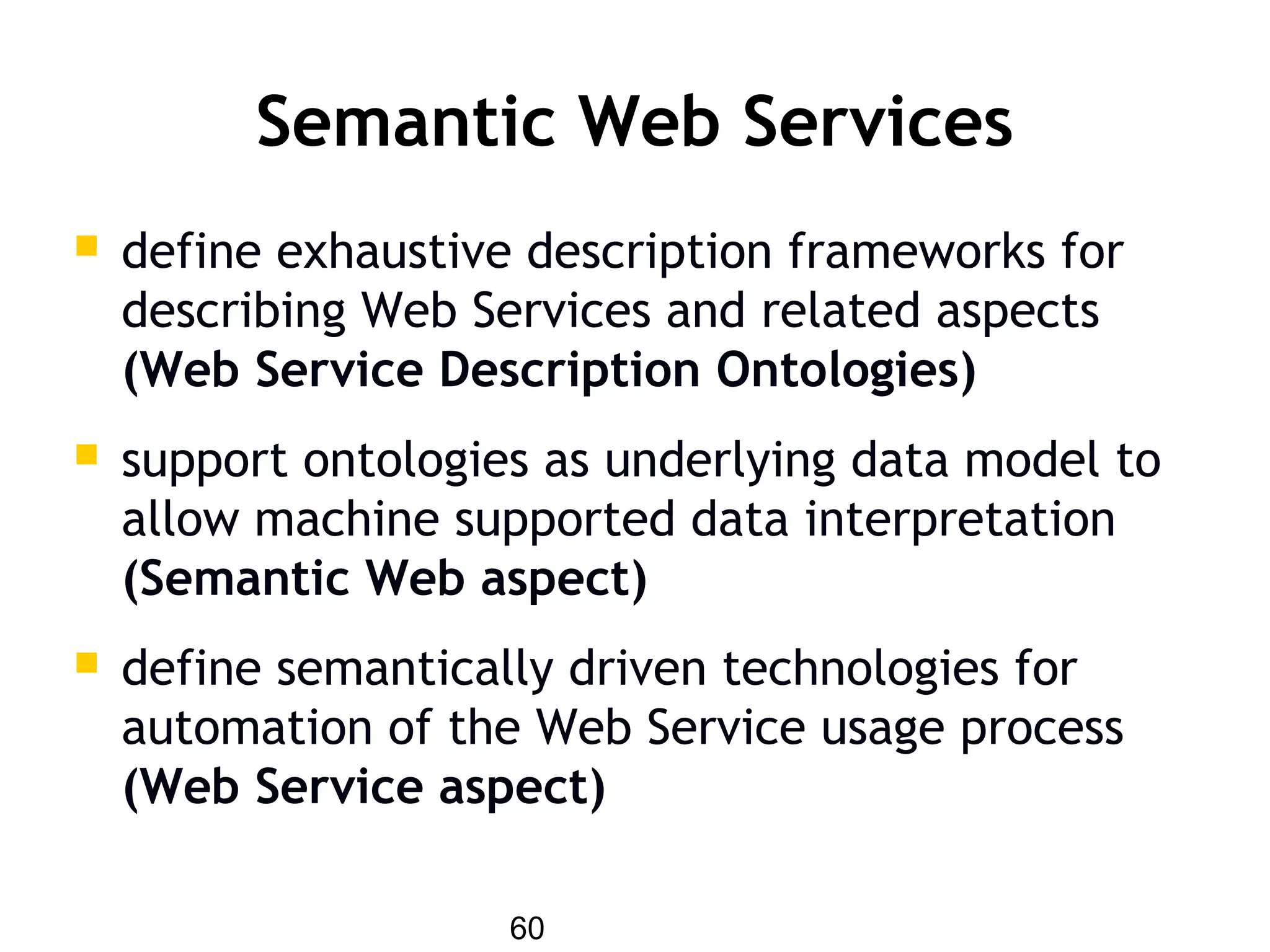This document provides an introduction to the Semantic Web and discusses its advantages over the current web. It explains that the Semantic Web aims to make web content machine-readable by representing information in a way that is defined and linked such that it can be understood by computers. Currently, most web content is designed for humans, but the Semantic Web seeks to encode meaning to support logic-based inferences and querying. The document outlines technologies like RDF, RDFS and OWL that are being developed to represent data in a structured format and establishes an ontology to formalize meaning.
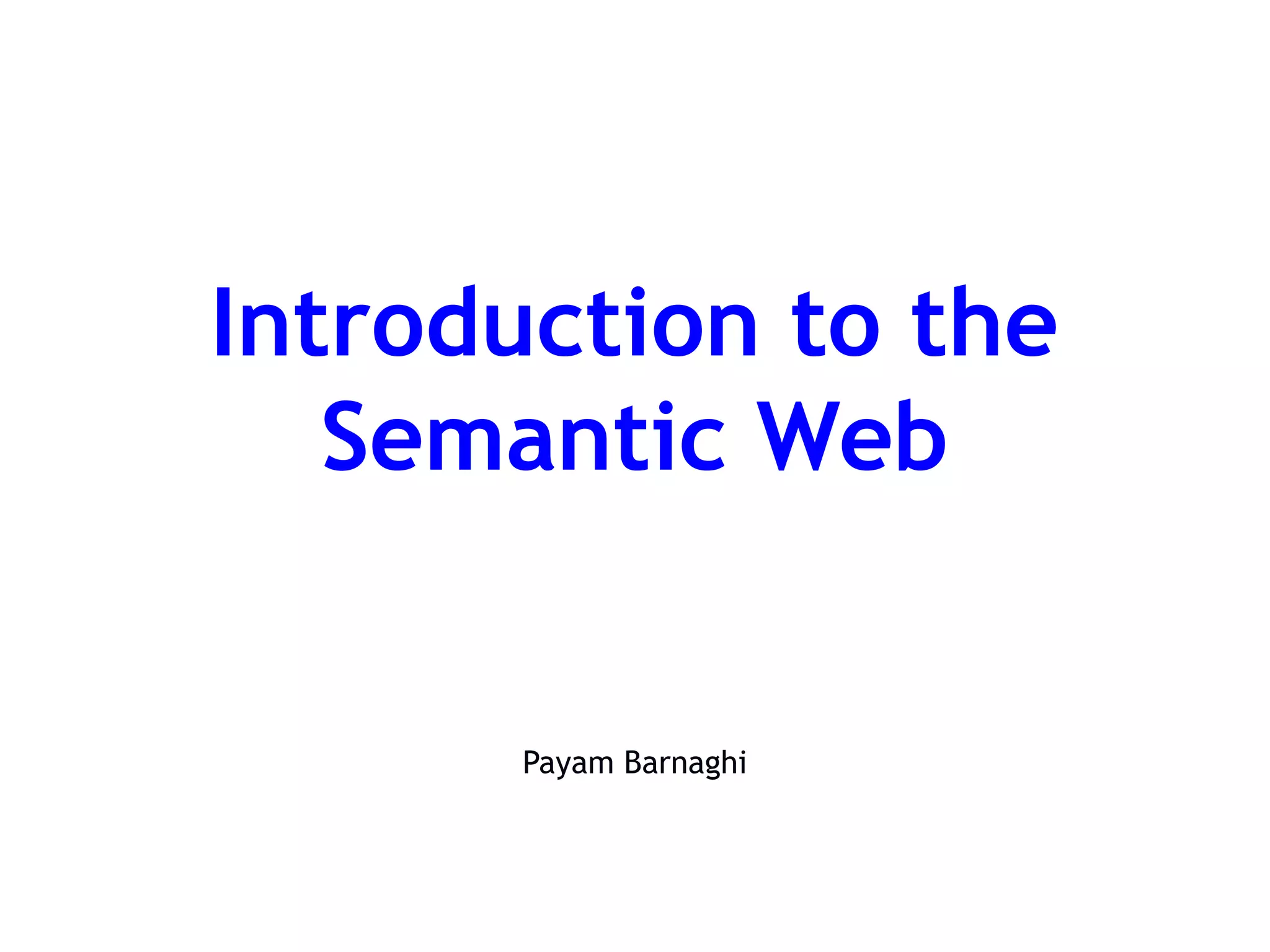
![2
The Semantic Web
“The Semantic Web is an extension of the
current web in which information is
given well-defined meaning, better
enabling computers and people to
work in co-operation.“
[Berners-Lee et al, 2001]](https://image.slidesharecdn.com/introsemanticweb-150426100529-conversion-gate02/75/Intro-semanticweb-2-2048.jpg)
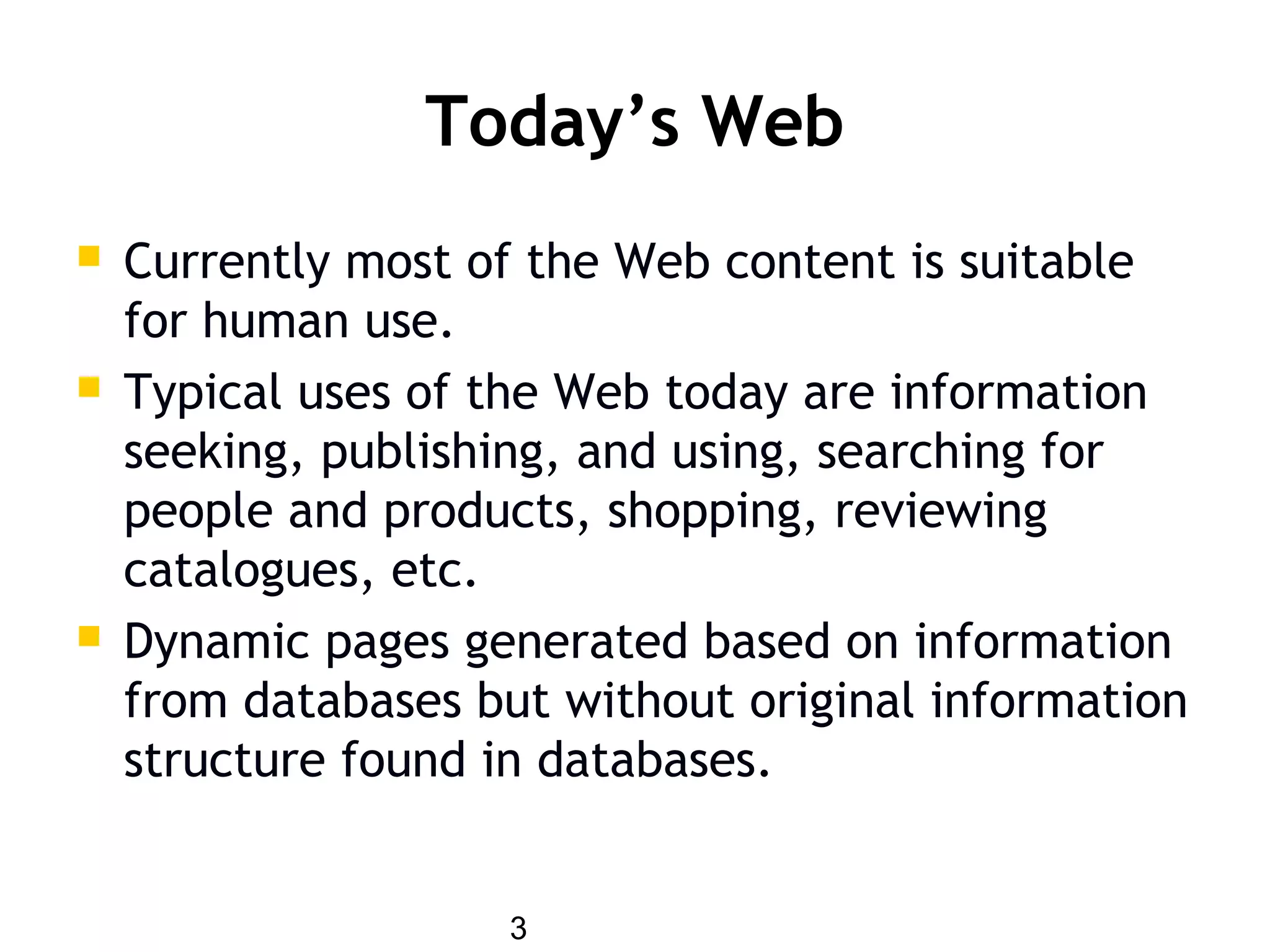
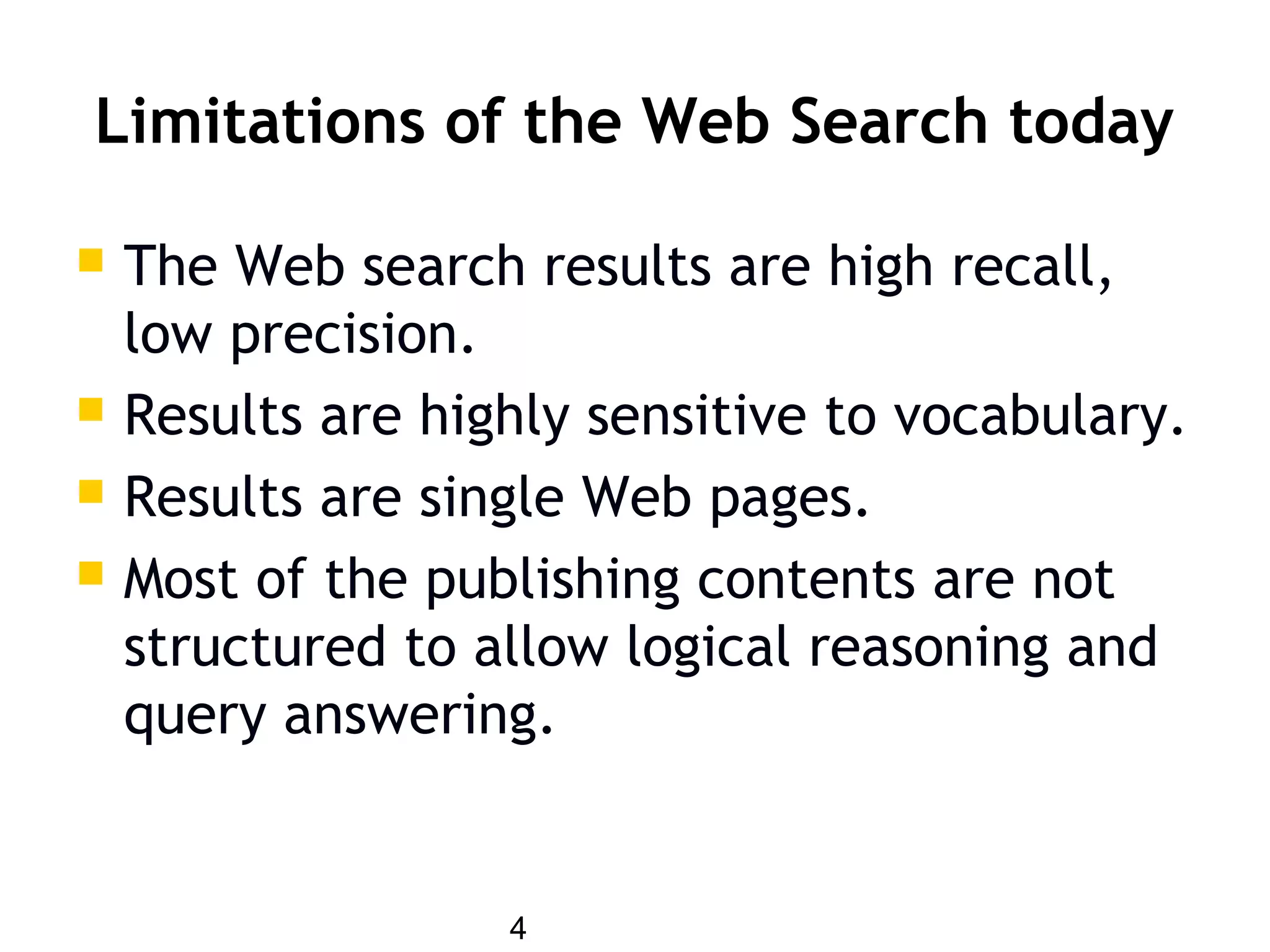

![6
What is a Web of Data?
Thinking back a bit... 1994
HTML and URIs
Markup language and means
for connecting resources
Below the file level
Stopped at the text level
[Miller 04]](https://image.slidesharecdn.com/introsemanticweb-150426100529-conversion-gate02/75/Intro-semanticweb-6-2048.jpg)
![7
What is a Web of Data?
(continued)
Now
XML, RDF, OWL and URIs
Markup language and means for
connecting resources
Below the file level
Below the text level
At the data level
[Miller 04]](https://image.slidesharecdn.com/introsemanticweb-150426100529-conversion-gate02/75/Intro-semanticweb-7-2048.jpg)
![8
The Syntactic Web
[Hendler & Miller 02]](https://image.slidesharecdn.com/introsemanticweb-150426100529-conversion-gate02/75/Intro-semanticweb-8-2048.jpg)
![9
What is the Problem?
Consider a typical web page:
Markup consists of:
rendering information
(e.g., font size and
colour)
Hyper-links to related
content
Semantic content is
accessible to humans but
not (easily) to
computers…
[Davies, 03]](https://image.slidesharecdn.com/introsemanticweb-150426100529-conversion-gate02/75/Intro-semanticweb-9-2048.jpg)
![10
i.e. the Syntactic Web is…
A place where
computers do the presentation (easy) and
people do the linking and interpreting (hard).
Why not get computers to do more of the
hard work?
[Goble, 03]](https://image.slidesharecdn.com/introsemanticweb-150426100529-conversion-gate02/75/Intro-semanticweb-10-2048.jpg)
![11
Web 2
It is all about people, collaboration,
media, ...
[The mind-map pictured above constructed by Markus Angermeier, source Wikipedia]](https://image.slidesharecdn.com/introsemanticweb-150426100529-conversion-gate02/75/Intro-semanticweb-11-2048.jpg)
![12
Web 2.0 and Folksonomies
[http://flickr.com/photos/tags/]](https://image.slidesharecdn.com/introsemanticweb-150426100529-conversion-gate02/75/Intro-semanticweb-12-2048.jpg)
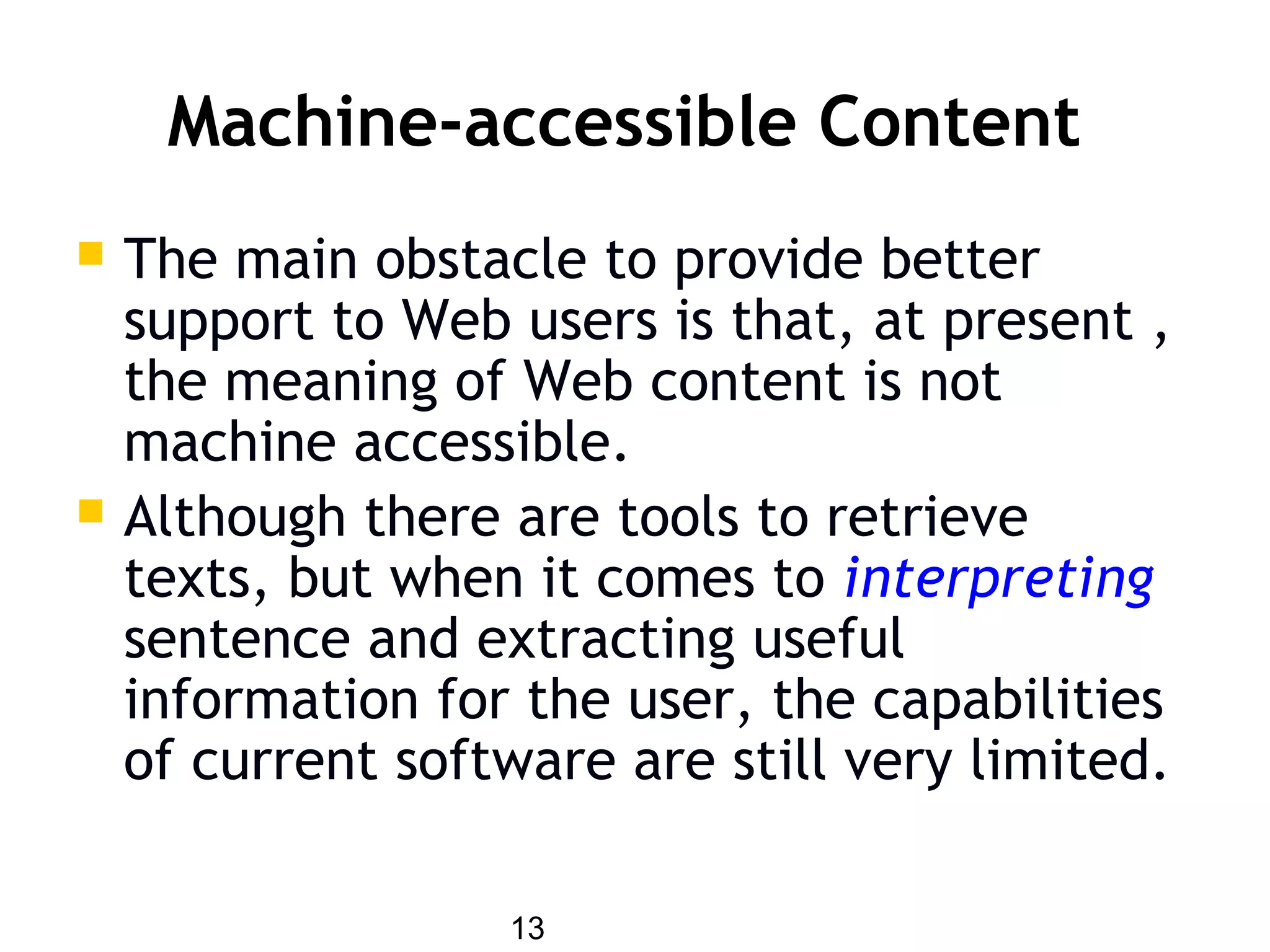
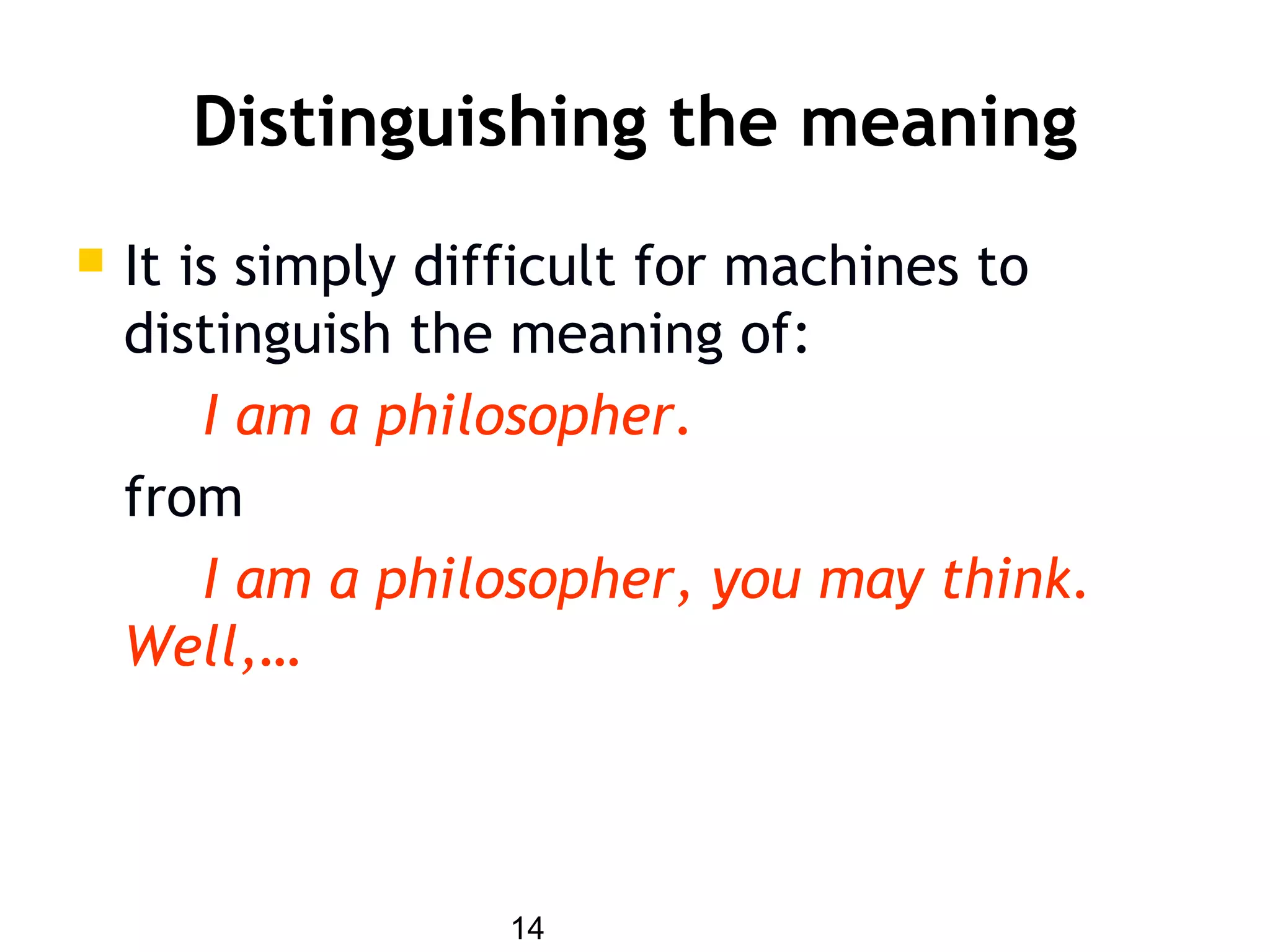
![15
…Limitations of the Web today
The Web activities are mostly focus on Machine-to-Human,
and Machine-to-Machine activities are not particularly well
supported by software tools.
[Davies, 03]](https://image.slidesharecdn.com/introsemanticweb-150426100529-conversion-gate02/75/Intro-semanticweb-15-2048.jpg)
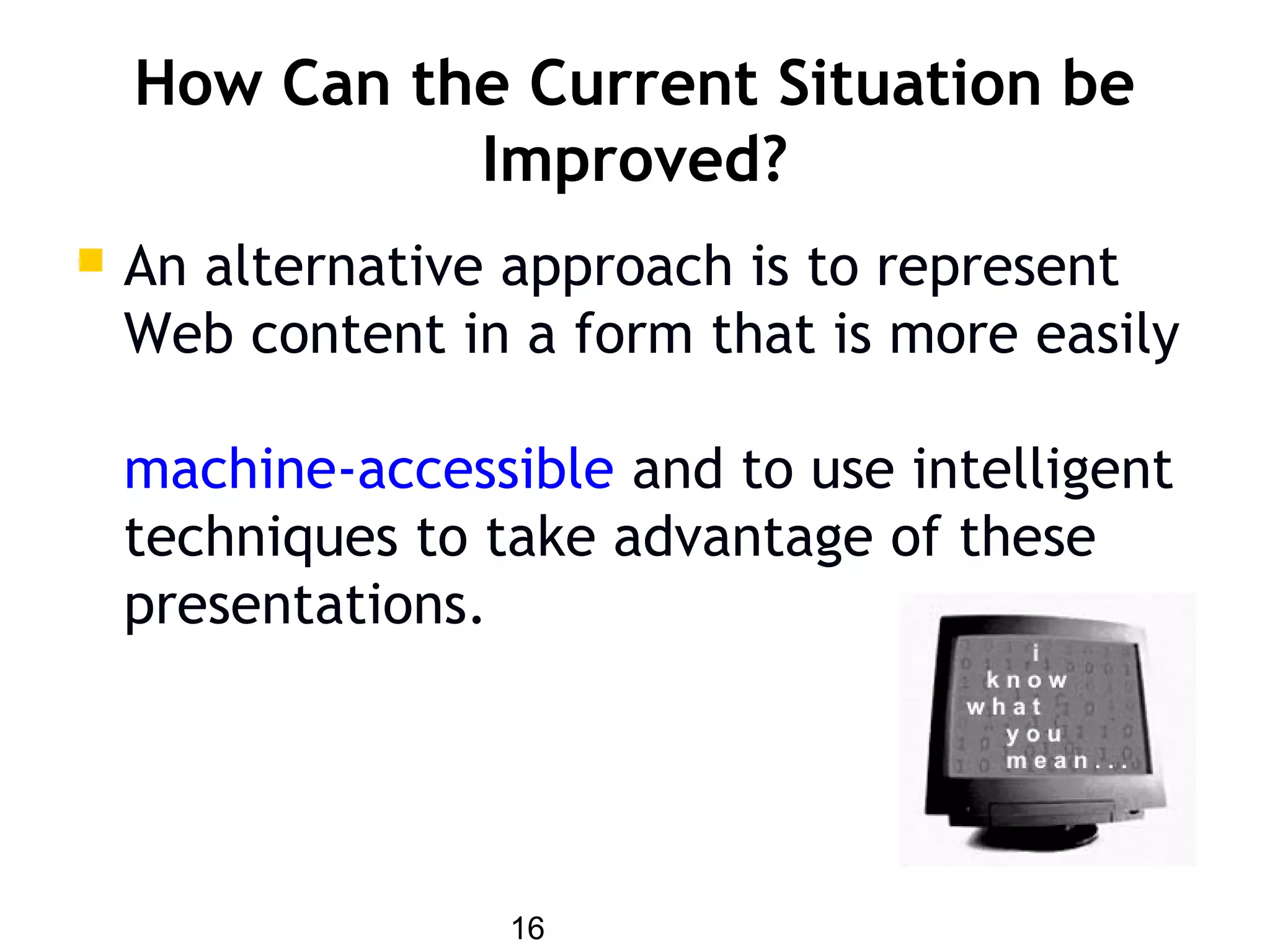
![17
Machine Accessible Meaning
CV
name
education
work
private
[Davies, 03]](https://image.slidesharecdn.com/introsemanticweb-150426100529-conversion-gate02/75/Intro-semanticweb-17-2048.jpg)
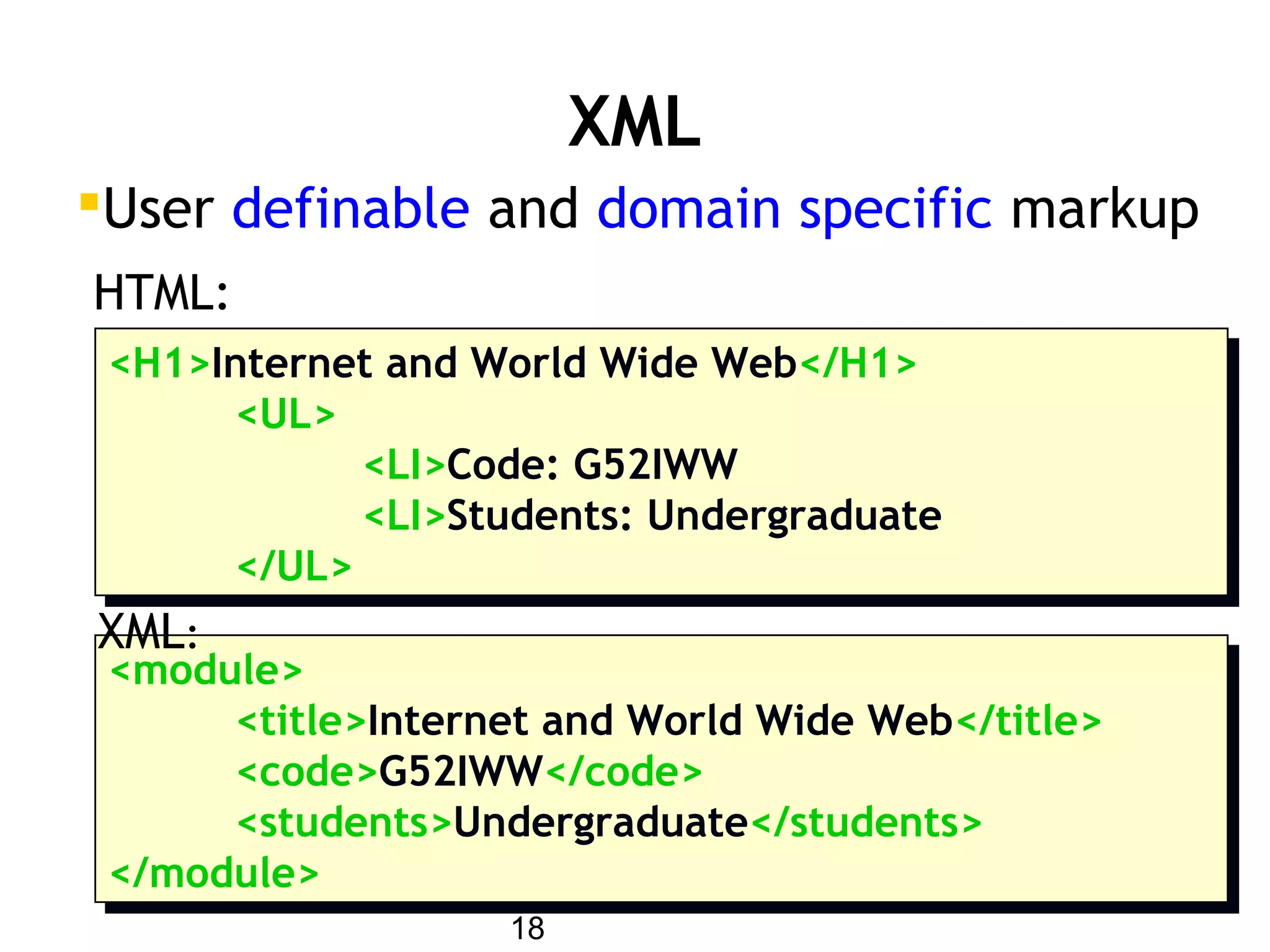
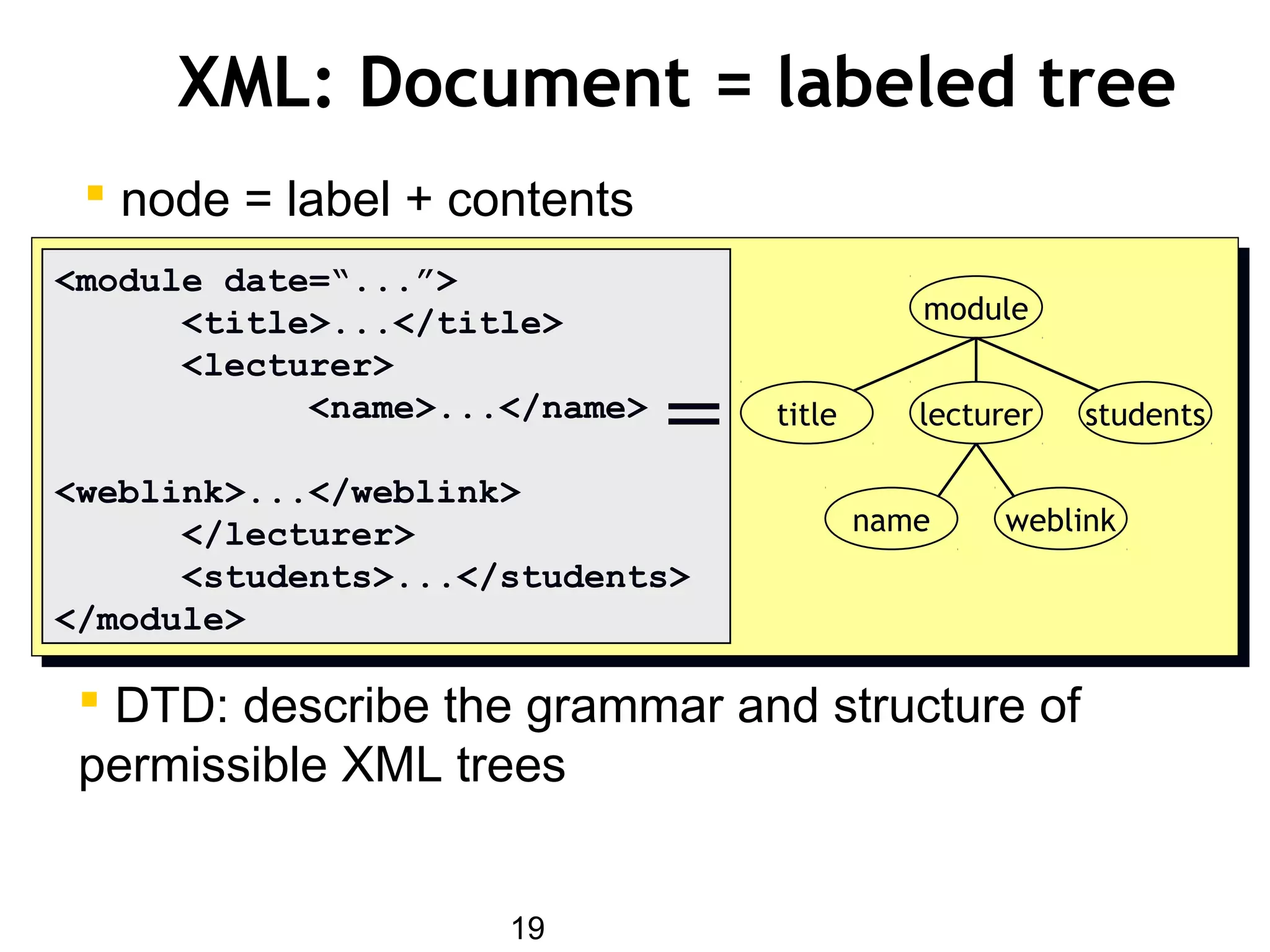
![20
But What about this?
CV
name
education
work
private
< >
< >
< >
< >
< >
< Χς >
< ναµε >
<εδυχατιον>
<ωορκ>
<πριϖατε>
[Davies, 03]](https://image.slidesharecdn.com/introsemanticweb-150426100529-conversion-gate02/75/Intro-semanticweb-20-2048.jpg)
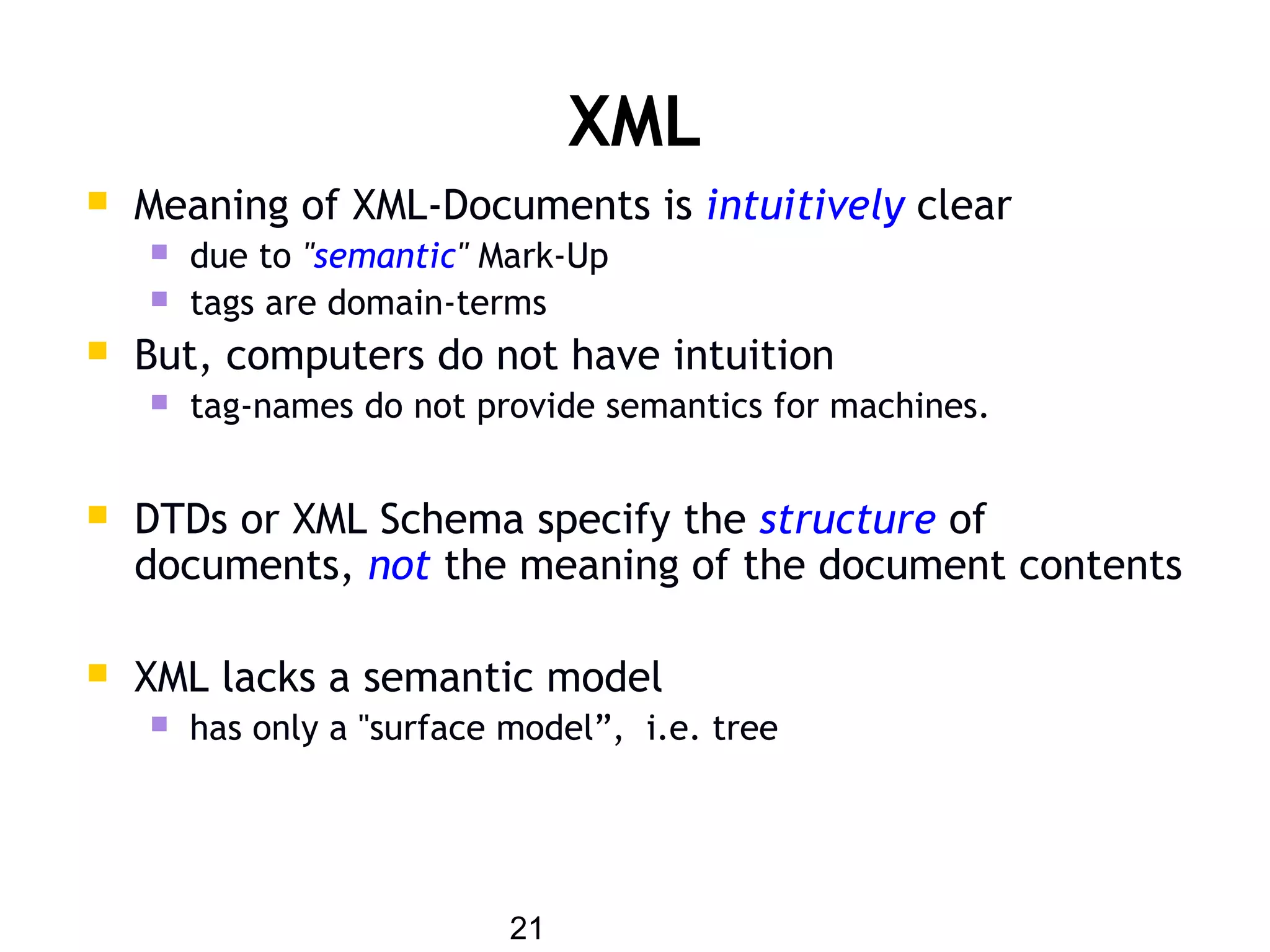
![22
XML:
limitations for semantic markup
XML representation makes no commitment on:
Domain specific ontological vocabulary
Which words shall we use to describe a given set of concepts?
Ontological modelling primitives
How can we combine these concepts, e.g. “car is a-kind-of (subclass-
of) vehicle”
requires pre-arranged agreement on vocabulary and
primitives
Only feasible for closed collaboration
agents in a small & stable community
pages on a small & stable intranet
.. not for sharable Web-resources
[Davies, 03]](https://image.slidesharecdn.com/introsemanticweb-150426100529-conversion-gate02/75/Intro-semanticweb-22-2048.jpg)
![23
XML is a first step
Semantic markup
HTML layout
XML content
Metadata
within documents, not across documents
prescriptive, not descriptive
No commitment on vocabulary and modelling
primitives
RDF is the next step
[Davies, 03]](https://image.slidesharecdn.com/introsemanticweb-150426100529-conversion-gate02/75/Intro-semanticweb-23-2048.jpg)
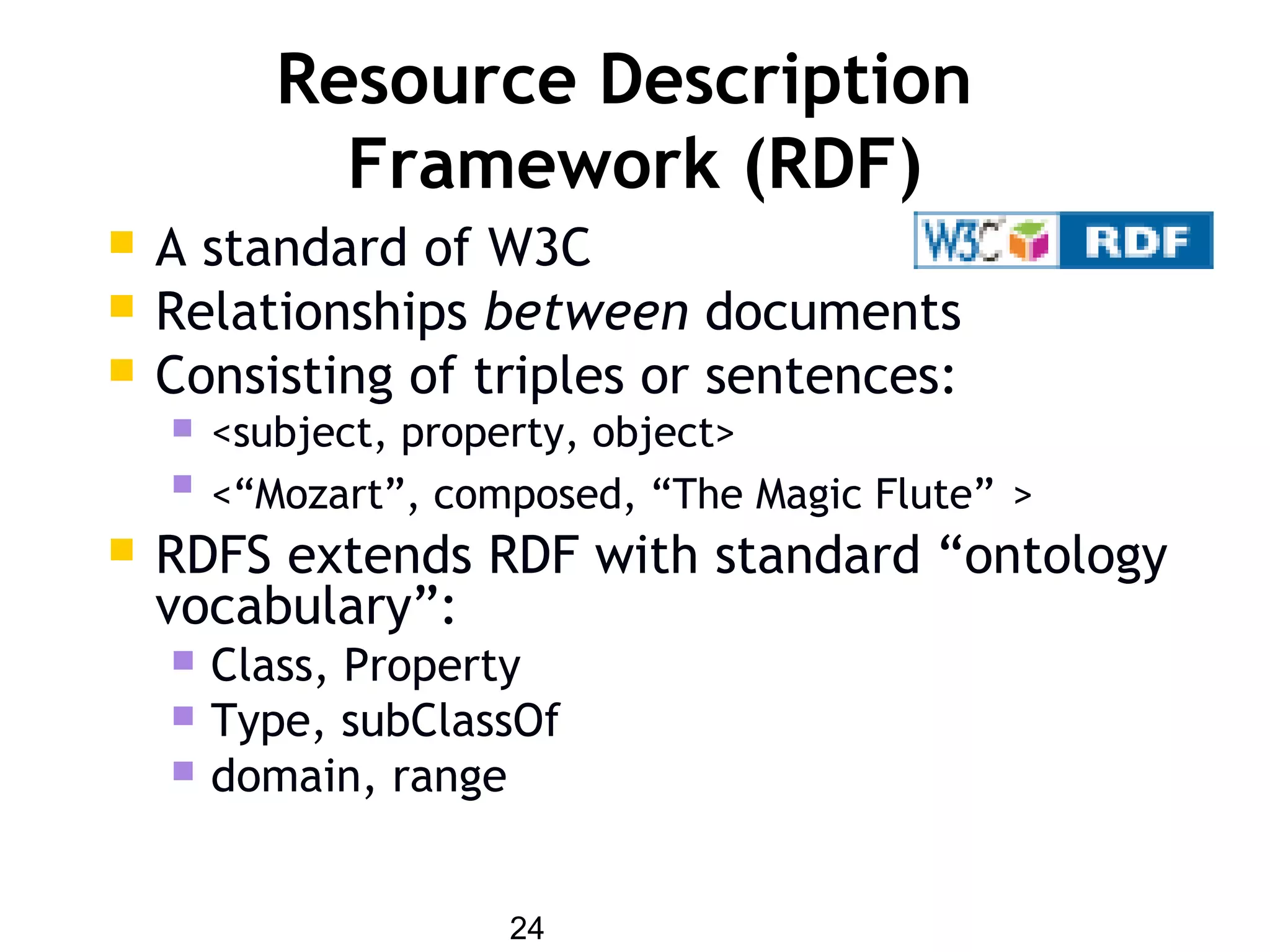

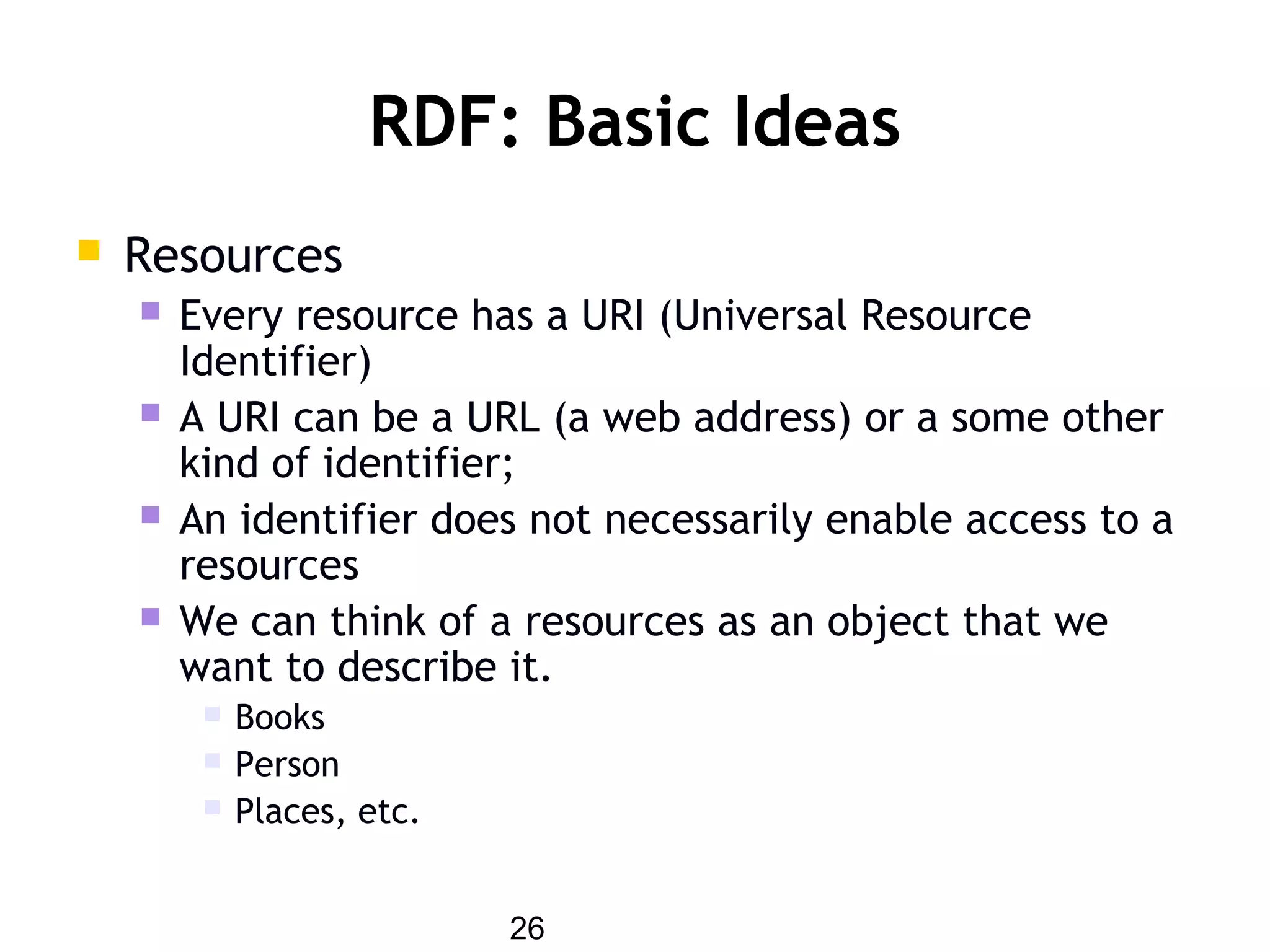
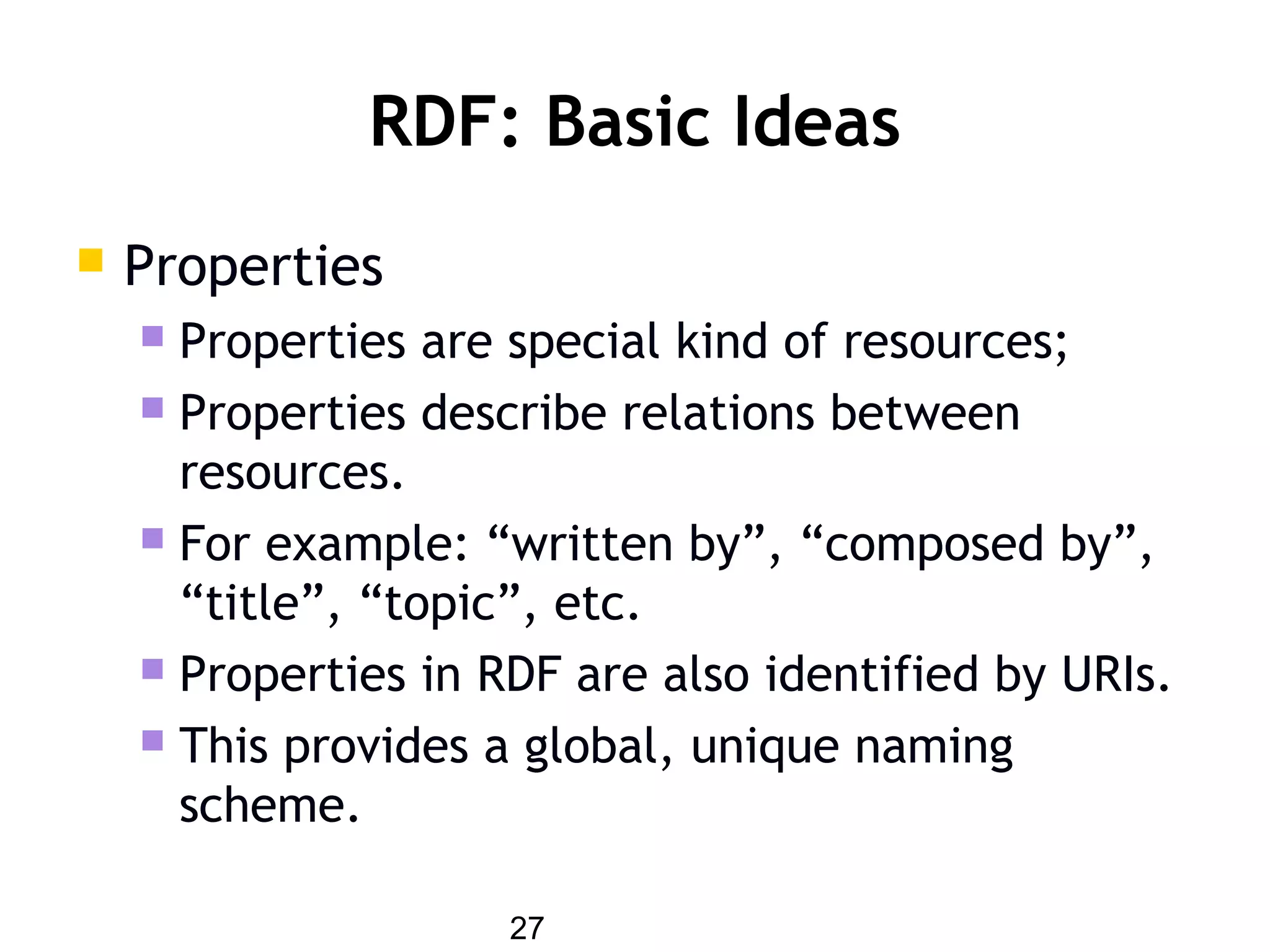
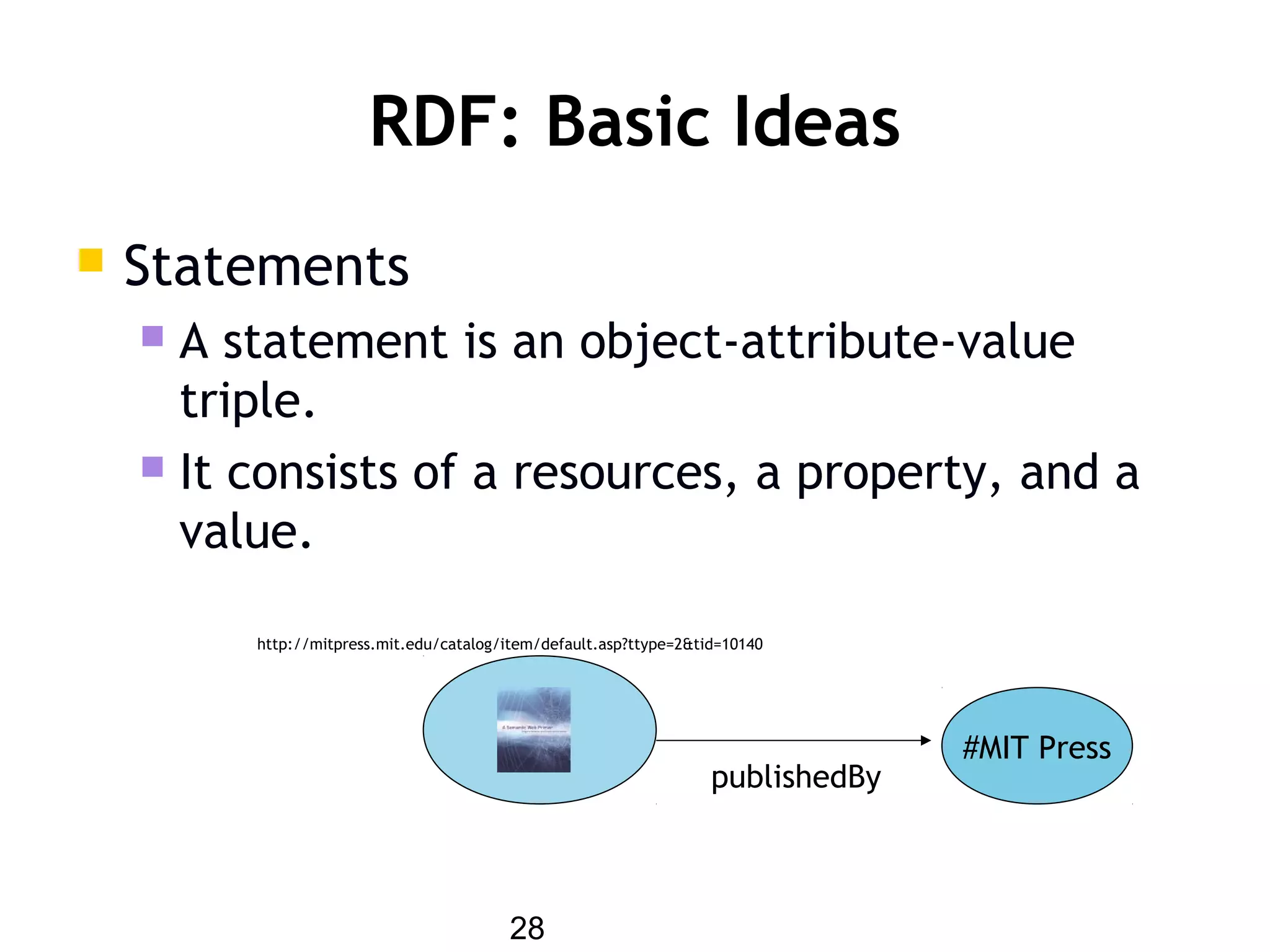
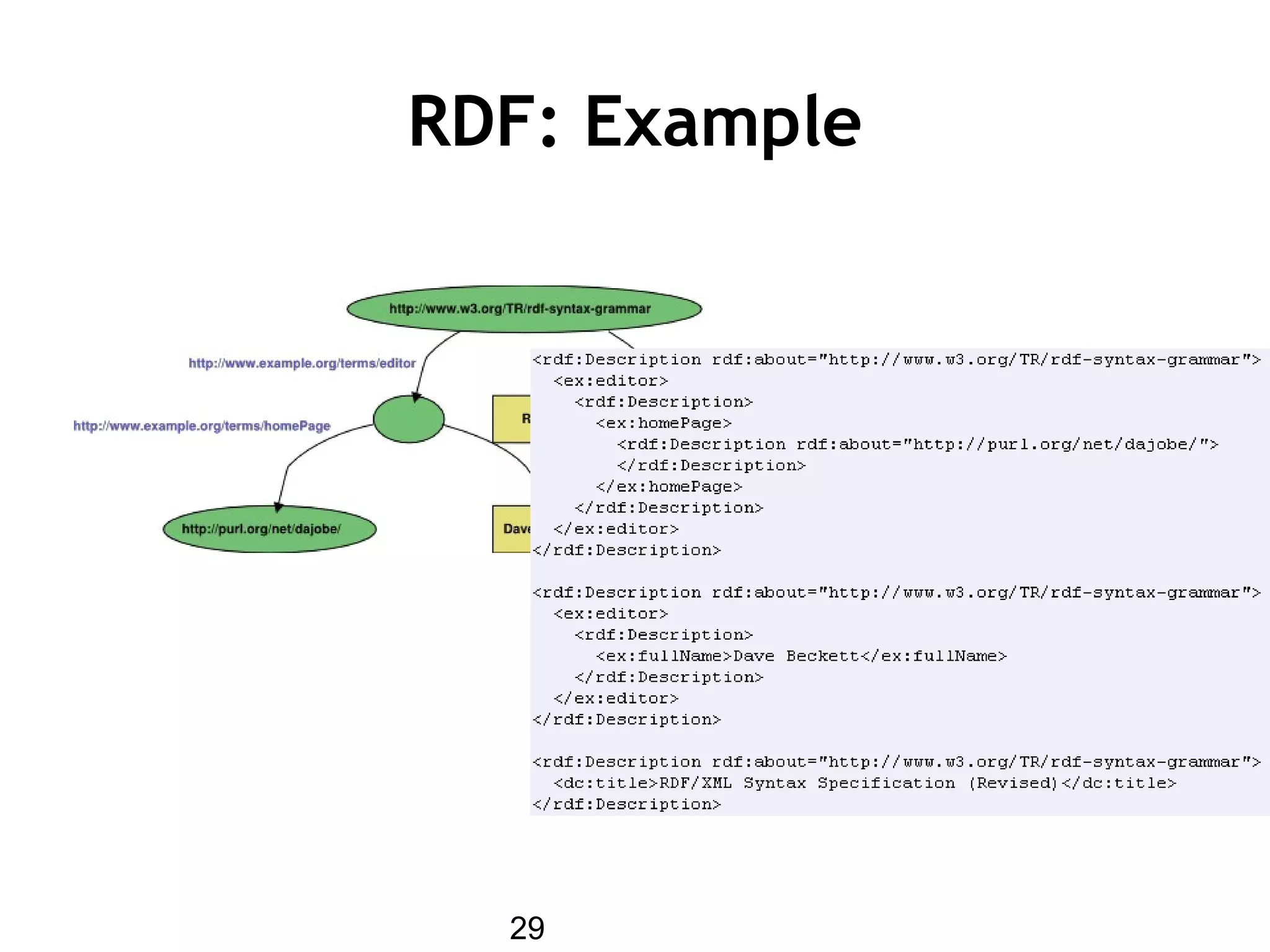
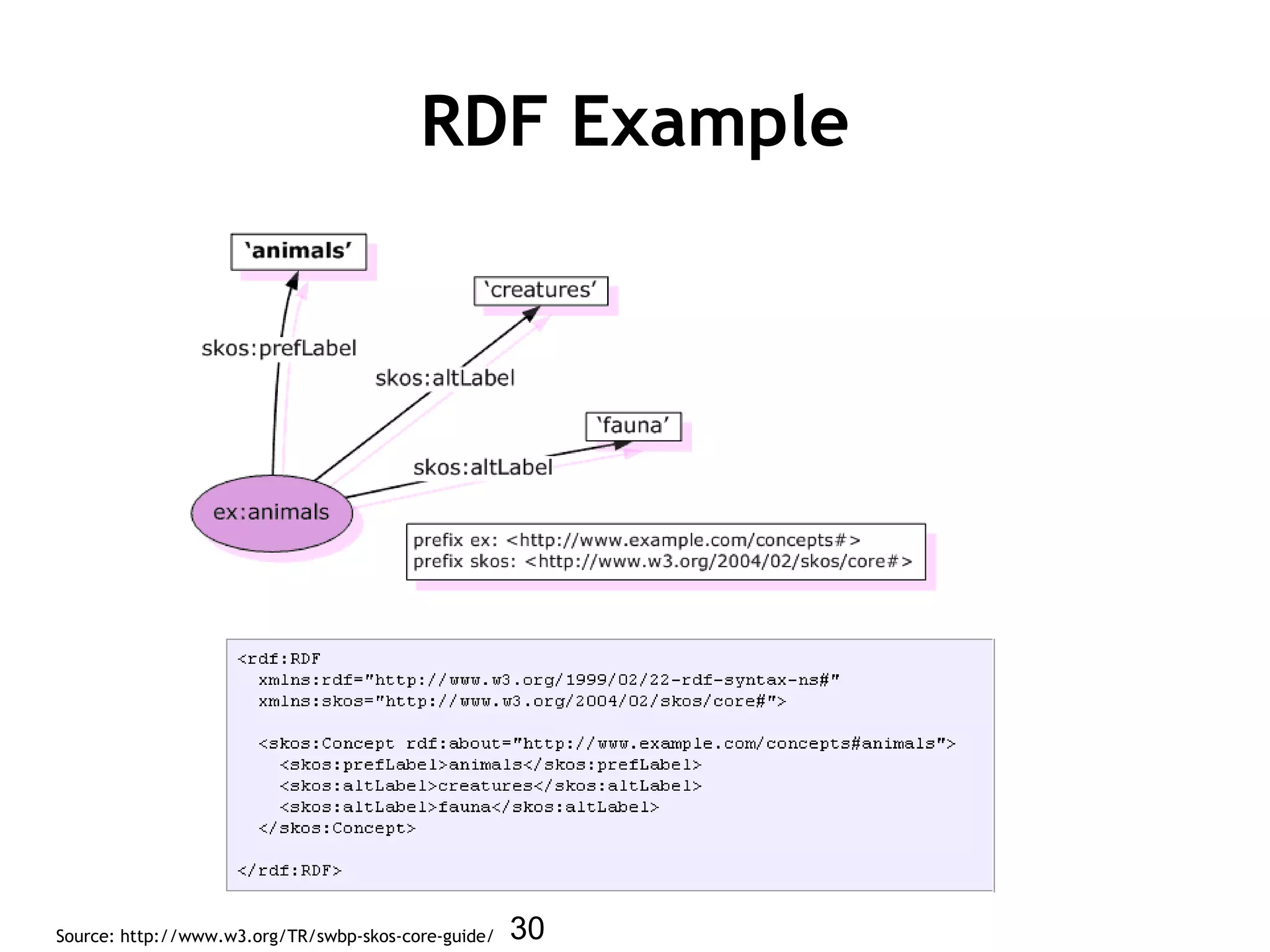
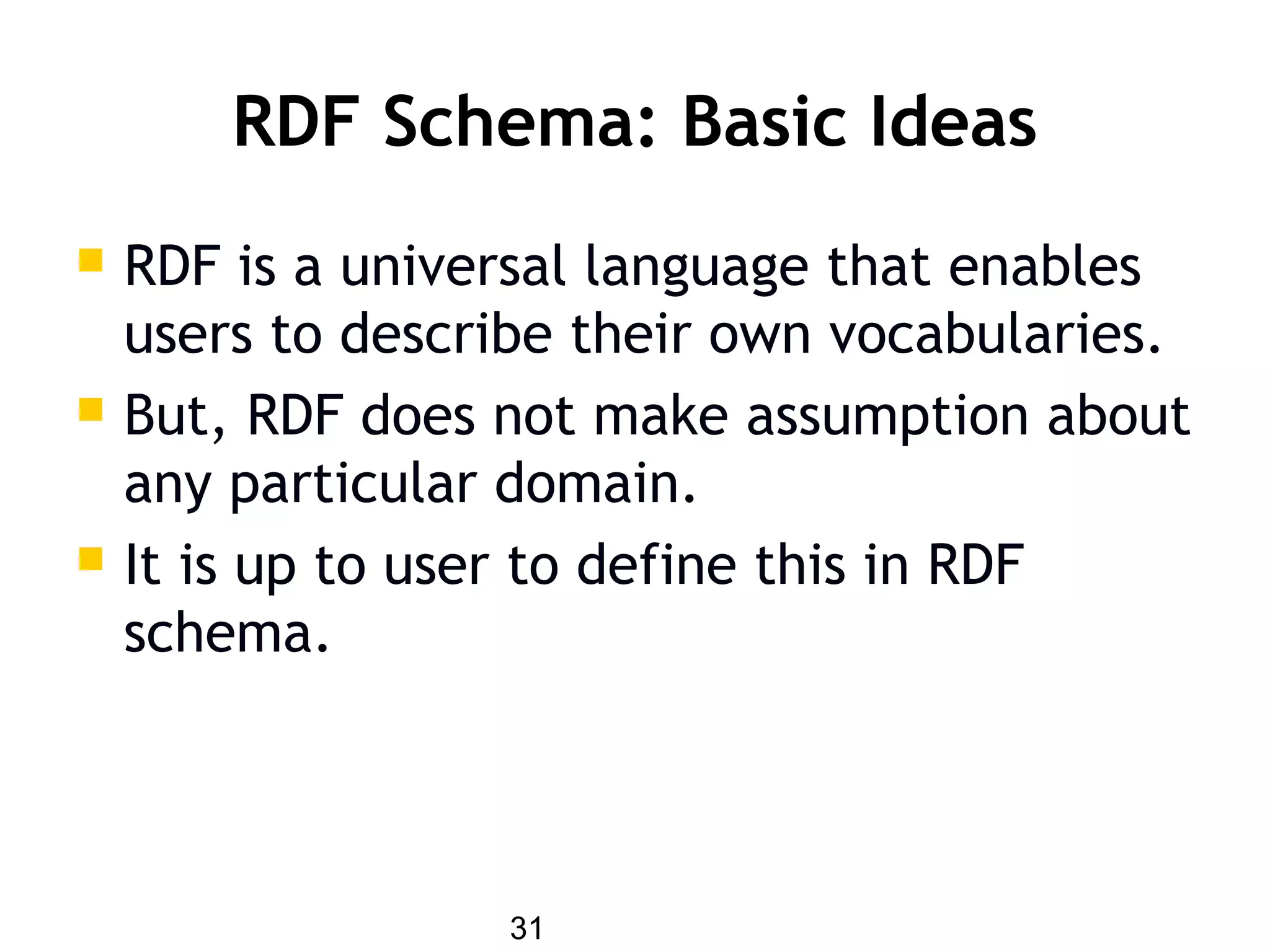
![32
What does RDF Schema add?
• Defines vocabulary for RDF
• Organizes this vocabulary in a typed hierarchy
• Class, subClassOf, type
• Property, subPropertyOf
• domain, range
AlanTom
Staff
Lecturer Research Assistant
subClassOf
subClassOf
type
supervisedBy
domain range
type
supervisedBy
[adapted from: Studer et al, 04]
Schema(RDFS)
Data(RDF)](https://image.slidesharecdn.com/introsemanticweb-150426100529-conversion-gate02/75/Intro-semanticweb-32-2048.jpg)
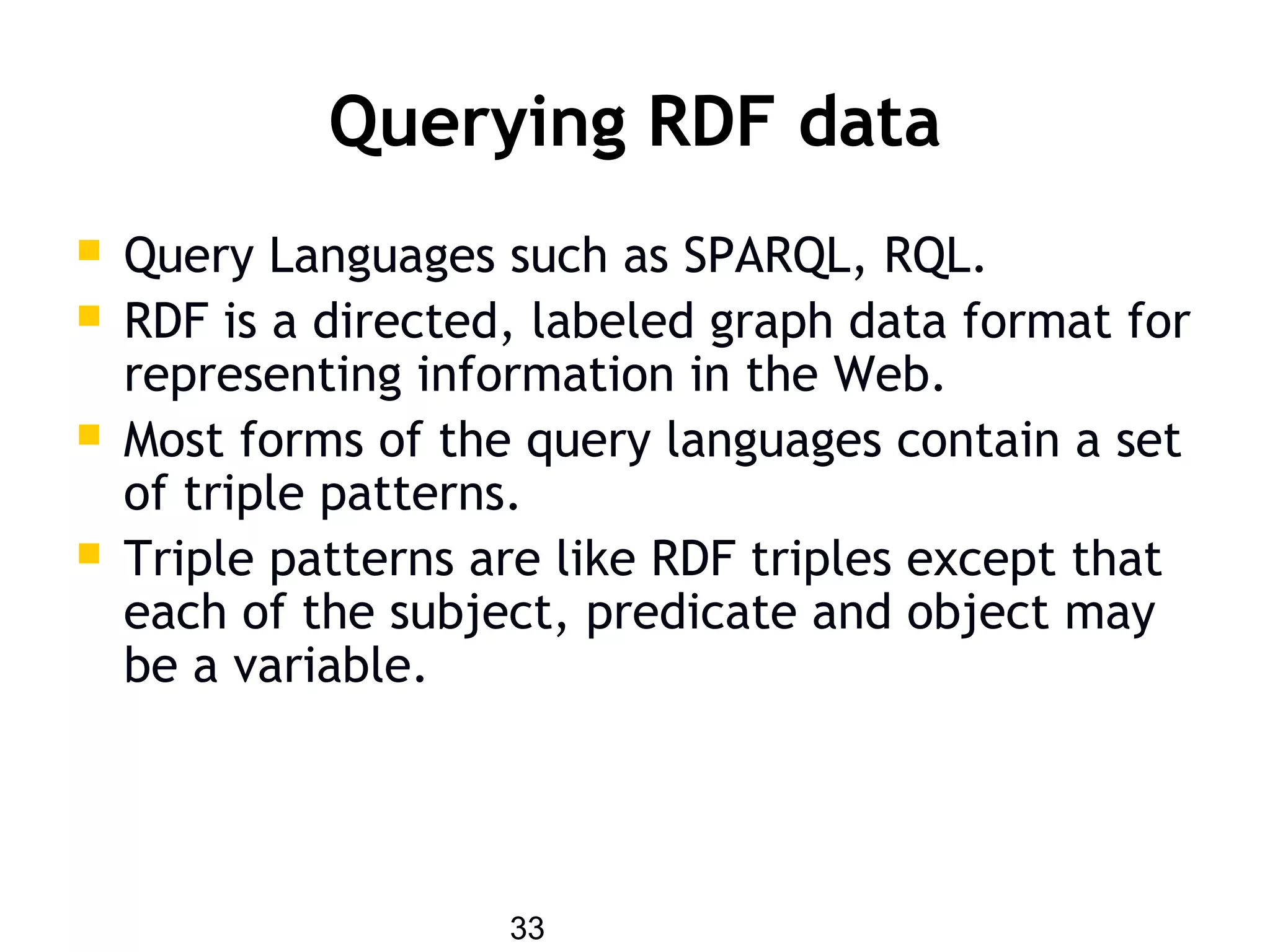
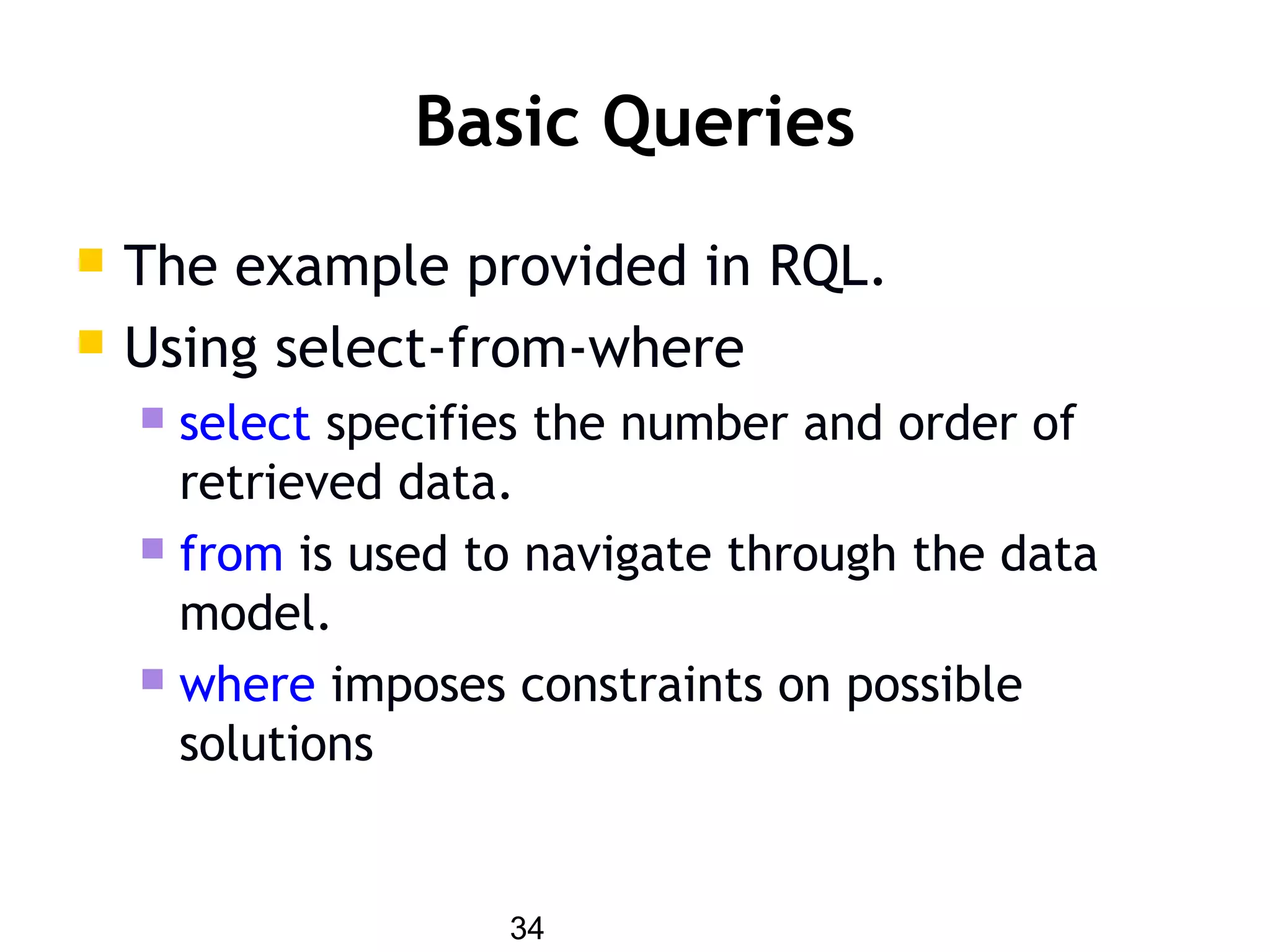
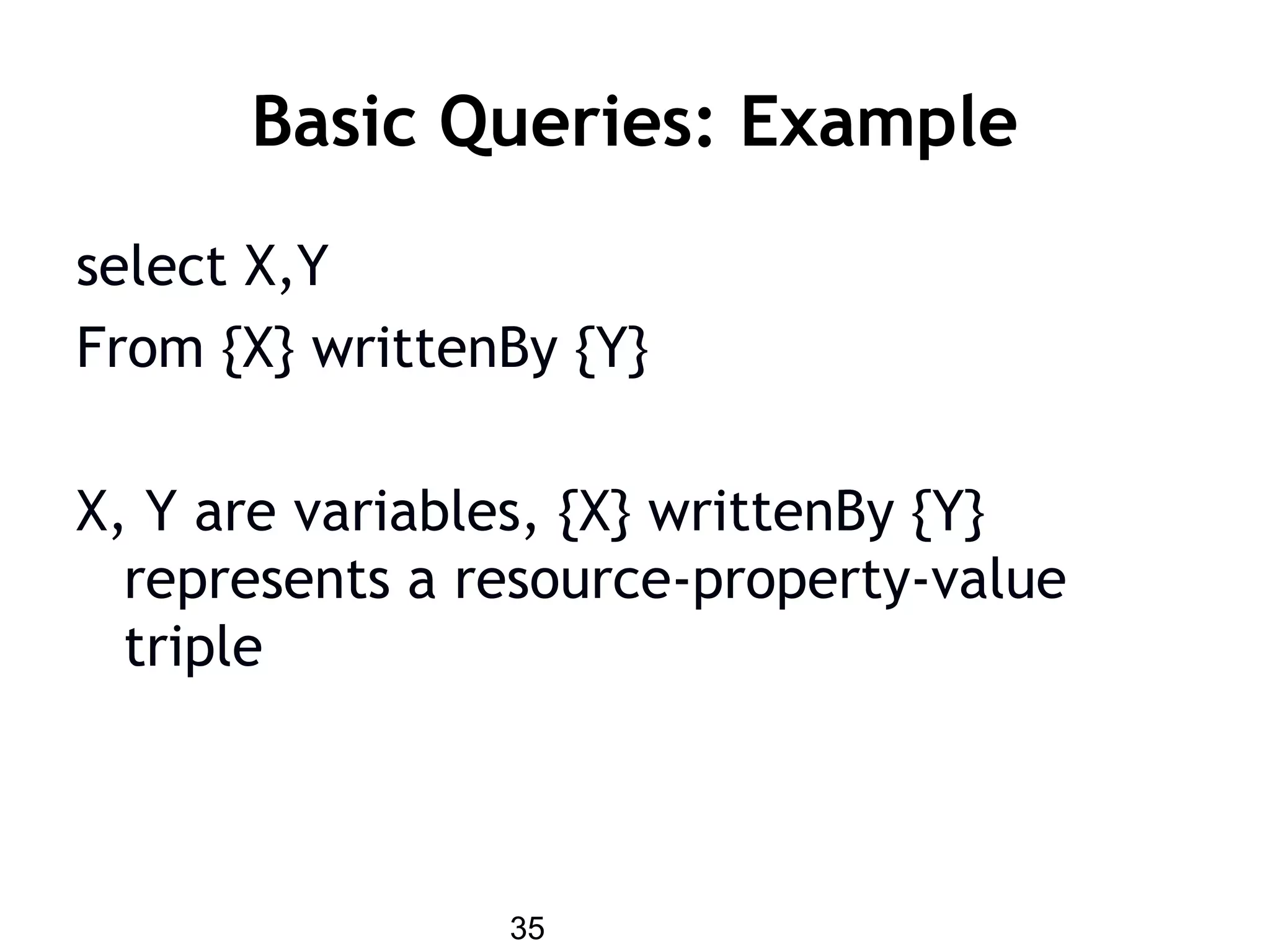
![36
Conclusions about RDF(S)
Next step up from plain XML:
(small) ontological commitment to modeling
primitives
possible to define vocabulary
However:
no precisely described meaning
no inference model
[Davies, 03]](https://image.slidesharecdn.com/introsemanticweb-150426100529-conversion-gate02/75/Intro-semanticweb-36-2048.jpg)
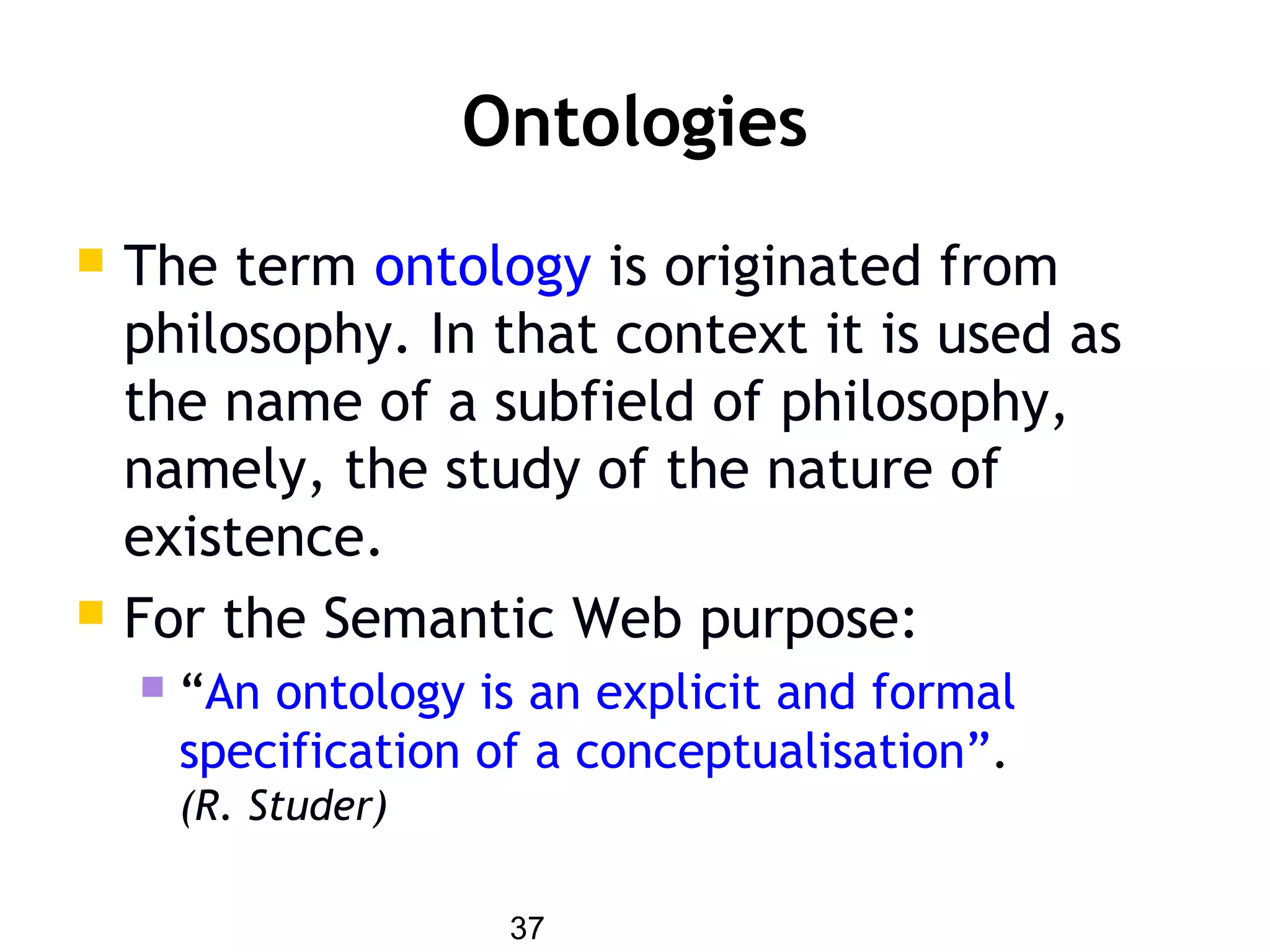
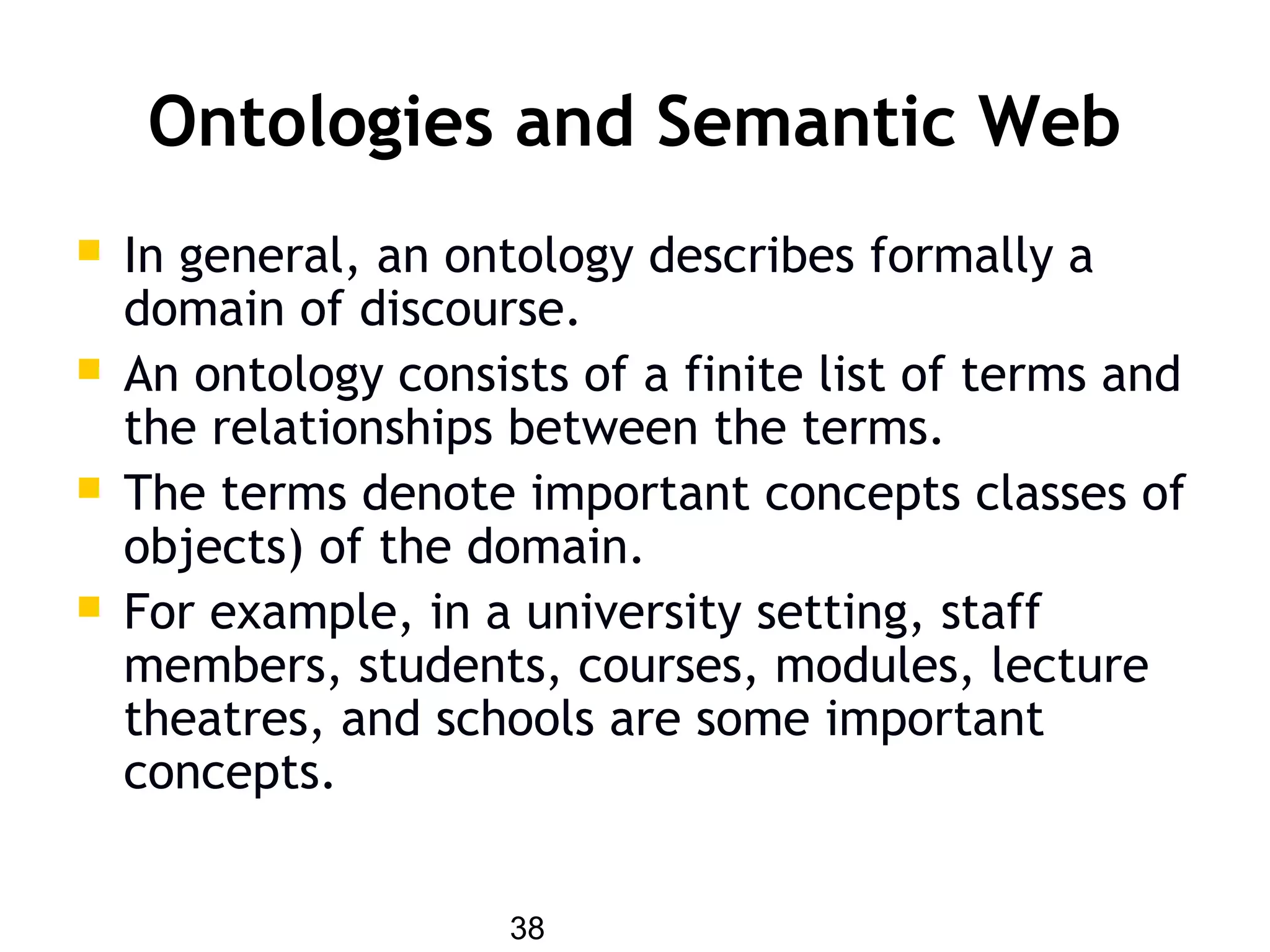
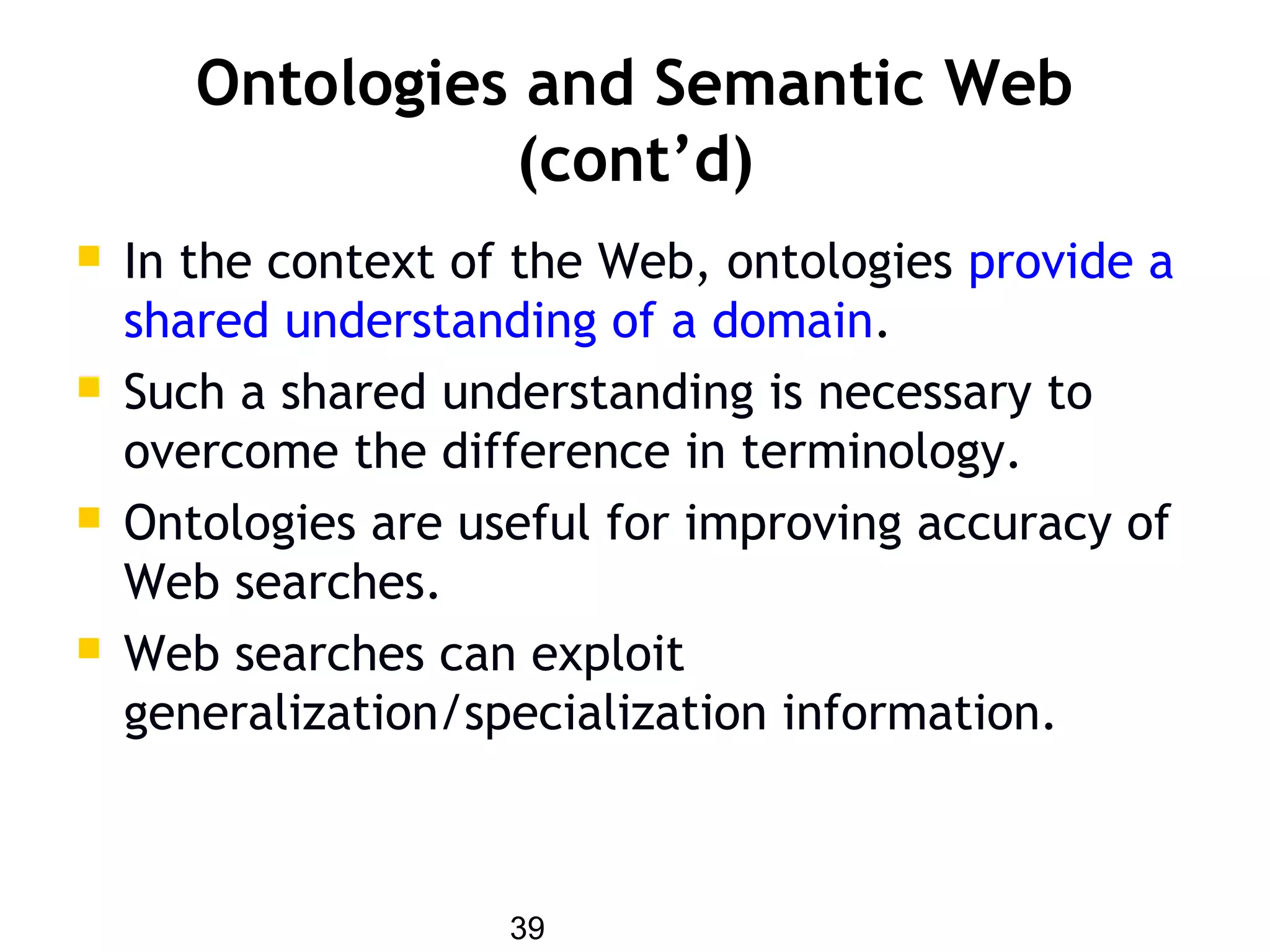
![40
OntologyF-Logic
similar
OntologyF-Logic
similar
PhD StudentDoktoral Student
Object
Person Topic Document
Tel
PhD StudentPhD Student
Semantics
knows described_in
writes
Affiliation
described_in is_about
knowsP writes D is_about T P T
DT T D
Rules
subTopicOf
• Major Paradigms: Logic Programming, Description Logic
• Standards: RDF(S); OWL
ResearcherStudent
instance_of
is_a
is_a
is_a
Affiliation
Affiliation
Siggi
AIFB+49 721 608 6554
A Sample Ontology
[Studer et al, 04]](https://image.slidesharecdn.com/introsemanticweb-150426100529-conversion-gate02/75/Intro-semanticweb-40-2048.jpg)
![41
PhD StudentPhD Student AssProfAssProf
AcademicStaffAcademicStaff
rdfs:subClassOfrdfs:subClassOf
cooperate_withcooperate_with
rdfs:range
rdfs:domain
Ontology
<swrc:AssProf rdf:ID="sst">
<swrc:name>Steffen Staab
</swrc:name>
...
</swrc:AssProf>
http://www.aifb.uni-karlsruhe.de/WBS/sst
Anno-
tation
<swrc:PhD_Student rdf:ID="sha">
<swrc:name>Siegfried
Handschuh</swrc:name>
...
</swrc:PhD_Student>
Web
Page
http://www.aifb.uni-karlsruhe.de/WBS/shaURL
<swrc:cooperate_with rdf:resource =
"http://www.aifb.uni-
karlsruhe.de/WBS/sst#sst"/>
instance of
instance
of
Cooperate_with
Ontology & Annotation
Links have explicit meanings!
[Studer et al, 04]](https://image.slidesharecdn.com/introsemanticweb-150426100529-conversion-gate02/75/Intro-semanticweb-41-2048.jpg)
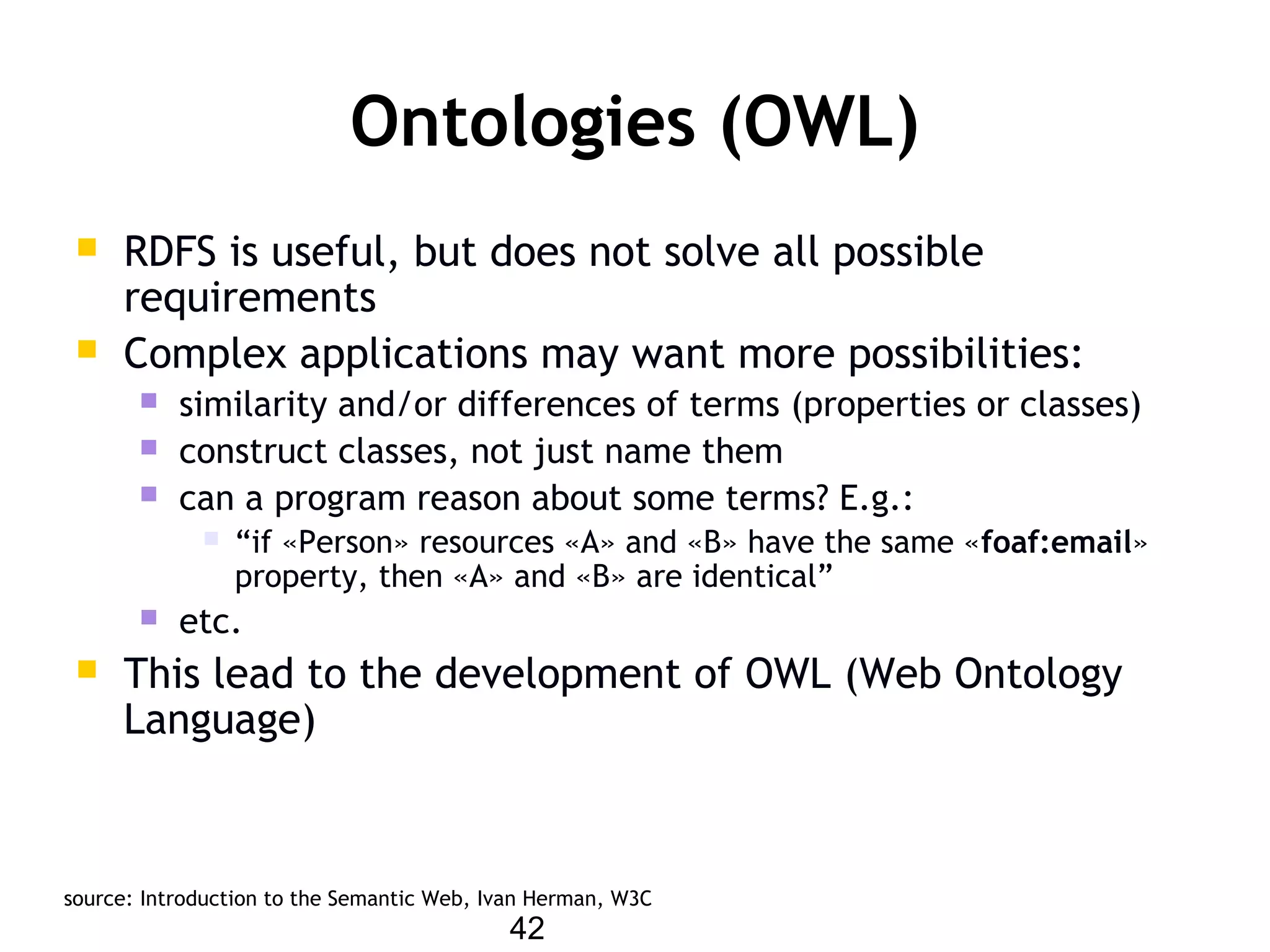
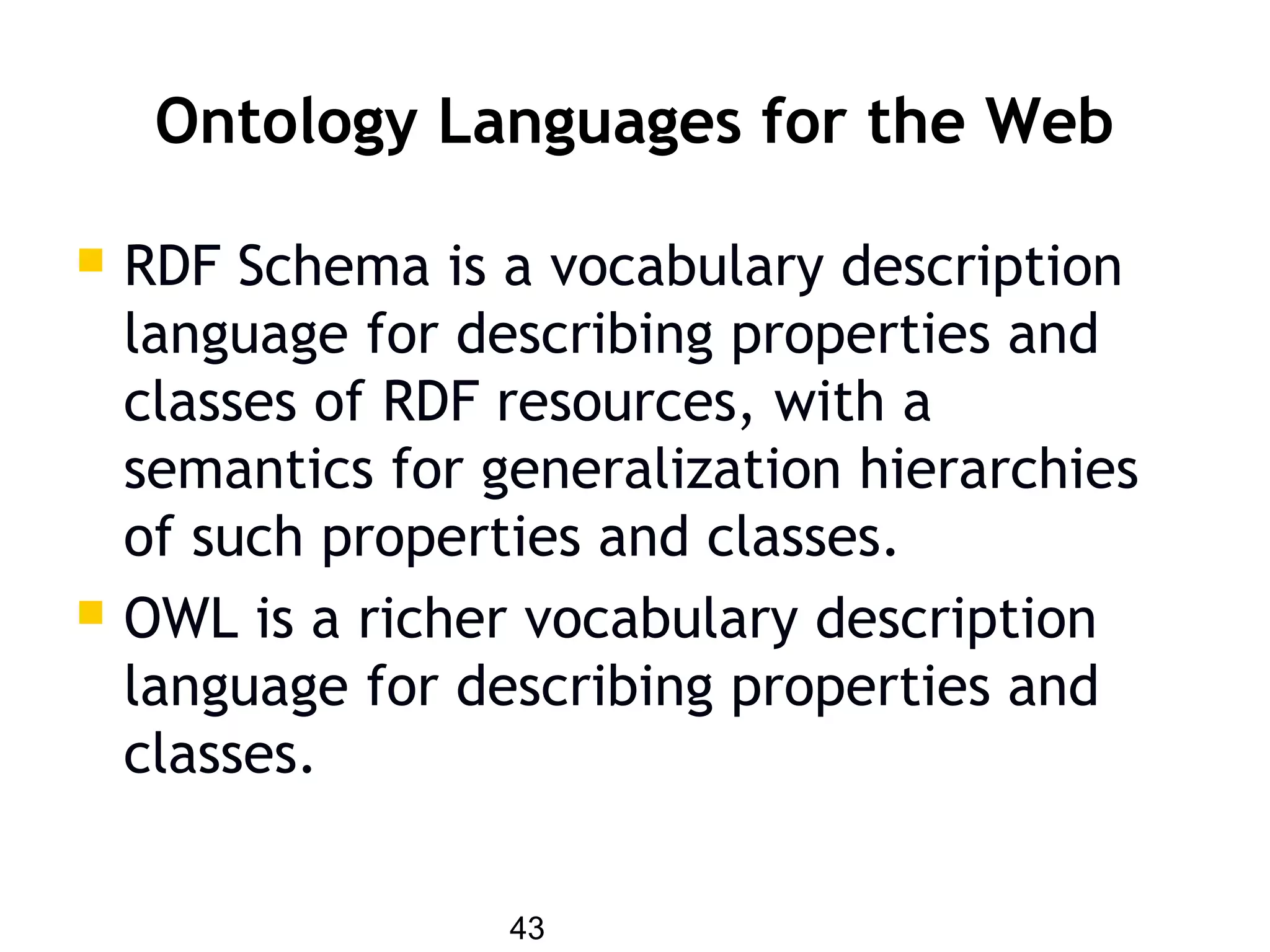
![44
OWL Language
OWL is based on Description Logics knowledge representation
formalism
OWL (DL) benefits from many years of DL research:
Well defined semantics
Formal properties well understood (complexity, decidability)
Known reasoning algorithms
Implemented systems (highly optimised)
Three species of OWL
OWL full is union of OWL syntax and RDF
OWL DL restricted to FOL fragment
OWL Lite is “easier to implement” subset of OWL DL
OWL DL based on SHIQ Description Logic
[Davies, 03]](https://image.slidesharecdn.com/introsemanticweb-150426100529-conversion-gate02/75/Intro-semanticweb-44-2048.jpg)
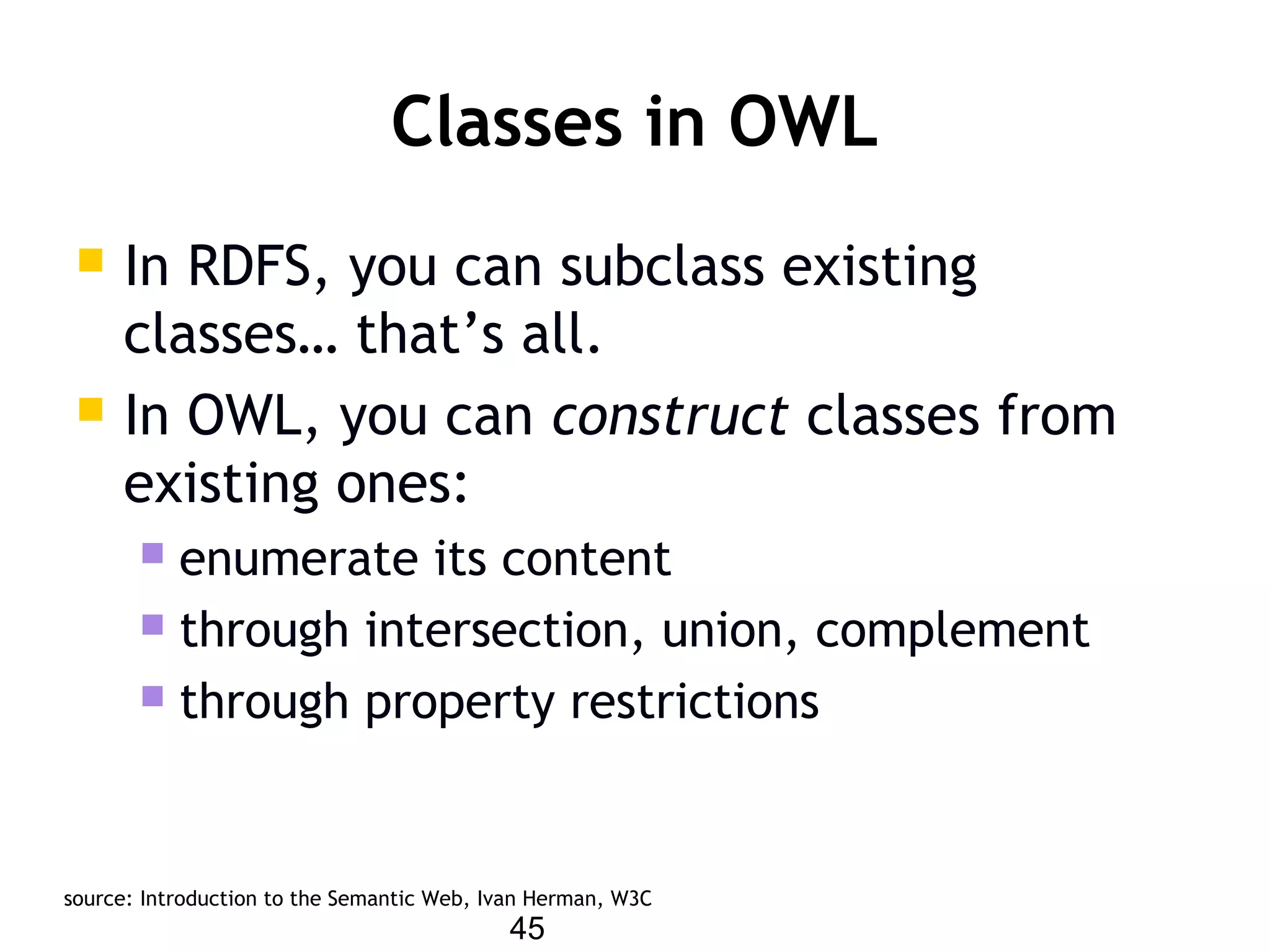
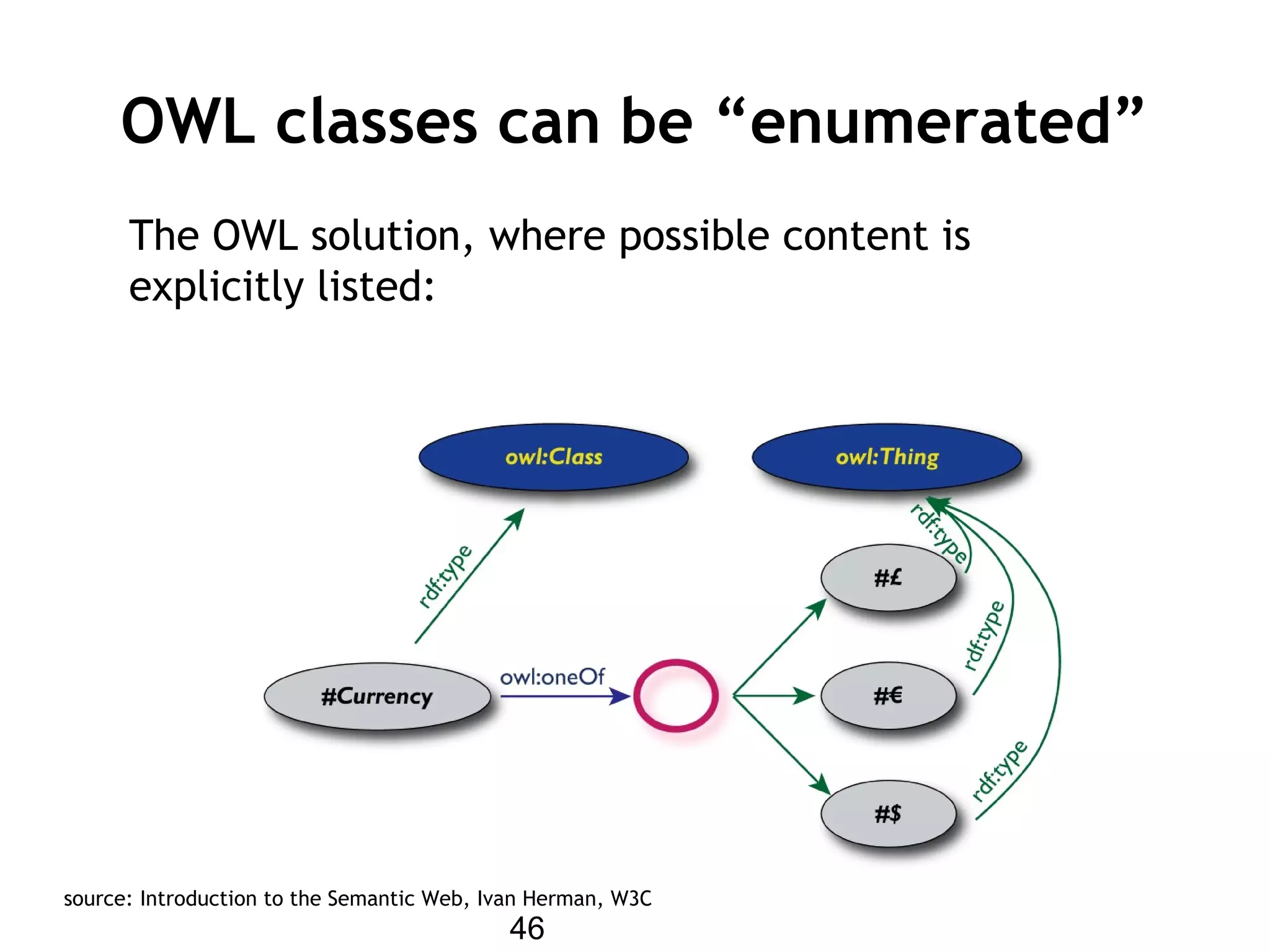
![47
Why develop an ontology?
To make define web resources more precisely and
make them more amenable to machine processing
To make domain assumptions explicit
Easier to change domain assumptions
Easier to understand and update legacy data
To separate domain knowledge from operational
knowledge
Re-use domain and operational knowledge separately
A community reference for applications
To share a consistent understanding of what information
means
[Davies, 03]](https://image.slidesharecdn.com/introsemanticweb-150426100529-conversion-gate02/75/Intro-semanticweb-47-2048.jpg)
![48
Ontology and Logic
Reasoning over ontologies
Inferencing capabilities
X is author of Y Y is written by X
X is supplier to Y; Y is supplier to Z
X and Z are part of the same supply chain
Cars are a kind of vehicle;
Vehicles have 2 or more wheels
Cars have 2 or more wheels
[Davies, 03]](https://image.slidesharecdn.com/introsemanticweb-150426100529-conversion-gate02/75/Intro-semanticweb-48-2048.jpg)
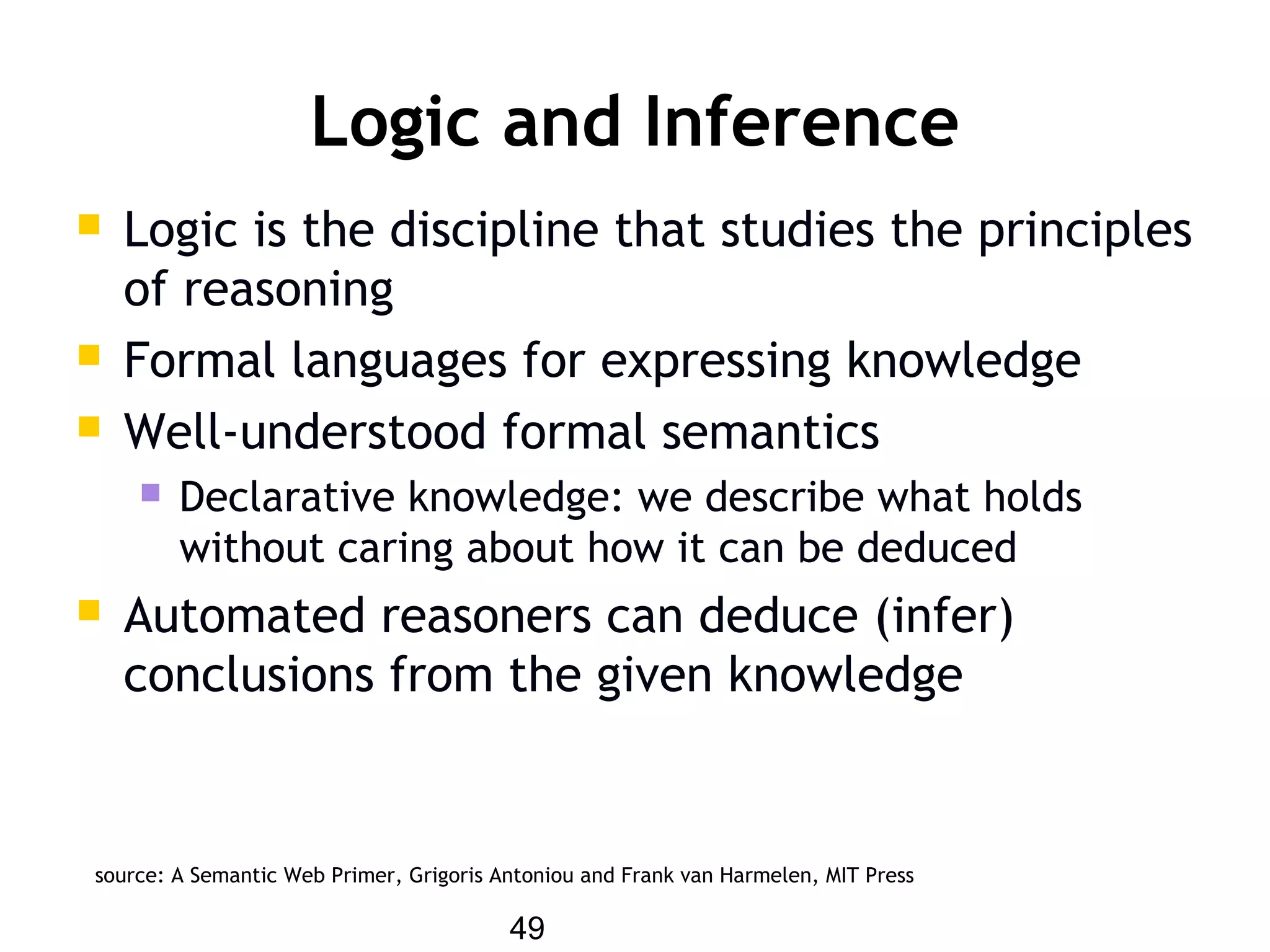
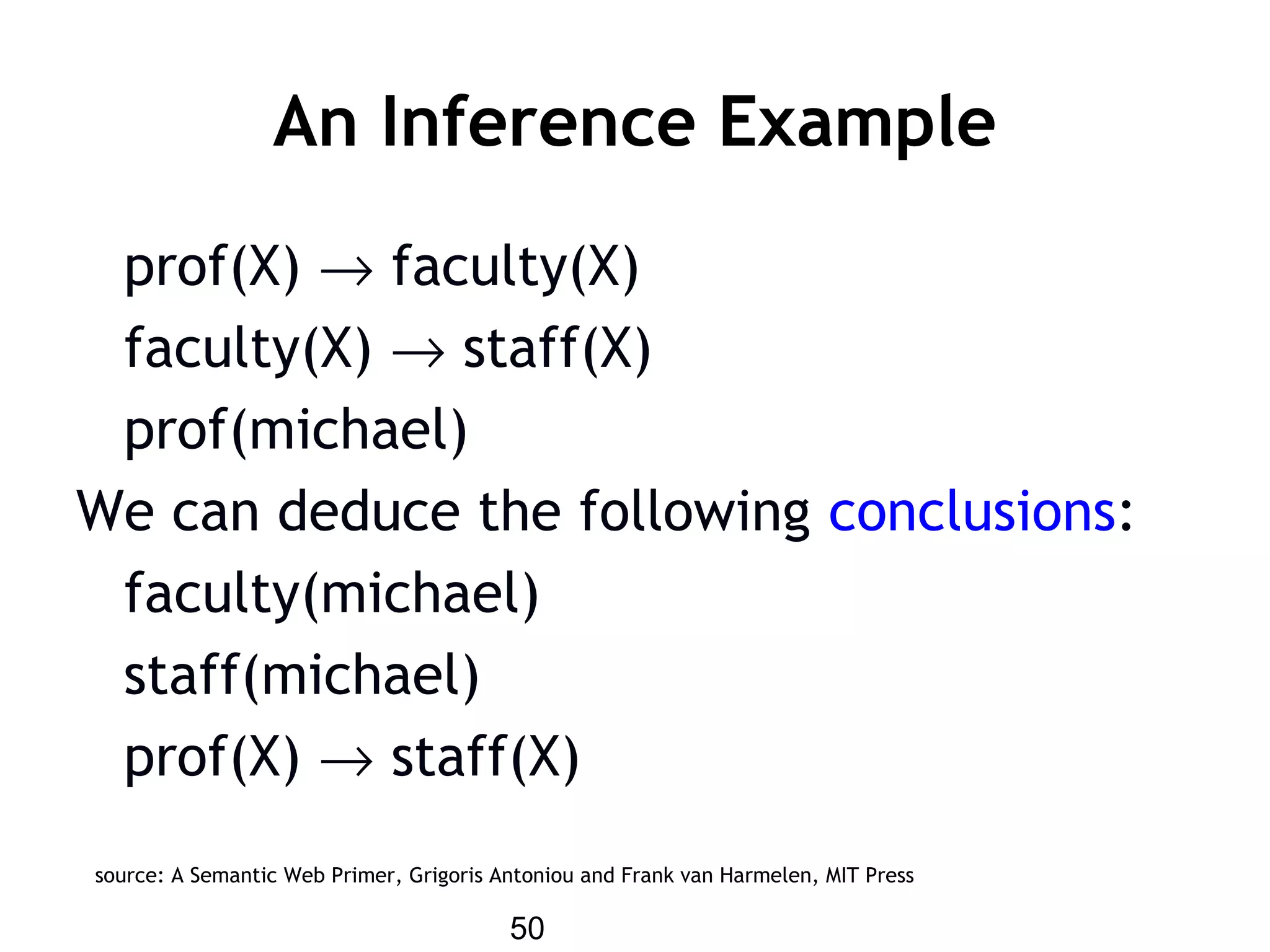
![51
Semantic Web Vision
Machine-processable, global
Web standards:
Assigning unambiguous
names (URI)
Expressing data, including
metadata (RDF)
Capturing ontologies (OWL)
Query, rules,
transformations,
deployment, application
spaces, logic, proofs, trust
(in progress)
[Source: Emerging Web Technologies to
Watch, Steve Bratt, W3C]](https://image.slidesharecdn.com/introsemanticweb-150426100529-conversion-gate02/75/Intro-semanticweb-51-2048.jpg)
![52
Semantic Web and AI?
No human-level intelligence claims
As with today’s WWW
large, inconsistent, distributed
Requirements
scalable, robust, decentralised
tolerant, mediated
Semantic Web will make extensive use of current AI,
any advancement in AI will lead to a better Semantic Web
Current AI is already sufficient to go towards realizing the
semantic web vision
As with WWW, Semantic Web will (need to) adapt fast
[Davies, 03]](https://image.slidesharecdn.com/introsemanticweb-150426100529-conversion-gate02/75/Intro-semanticweb-52-2048.jpg)
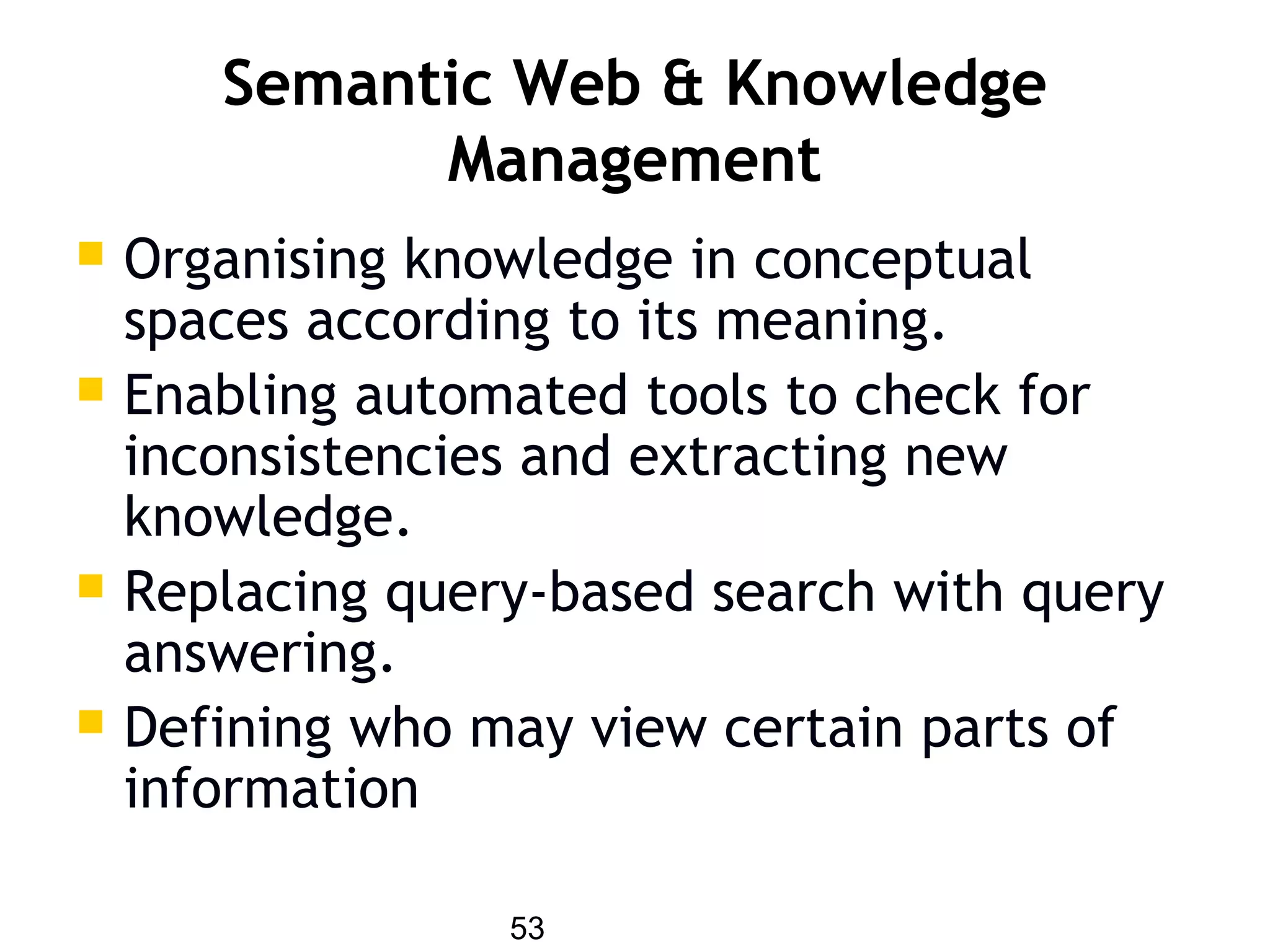
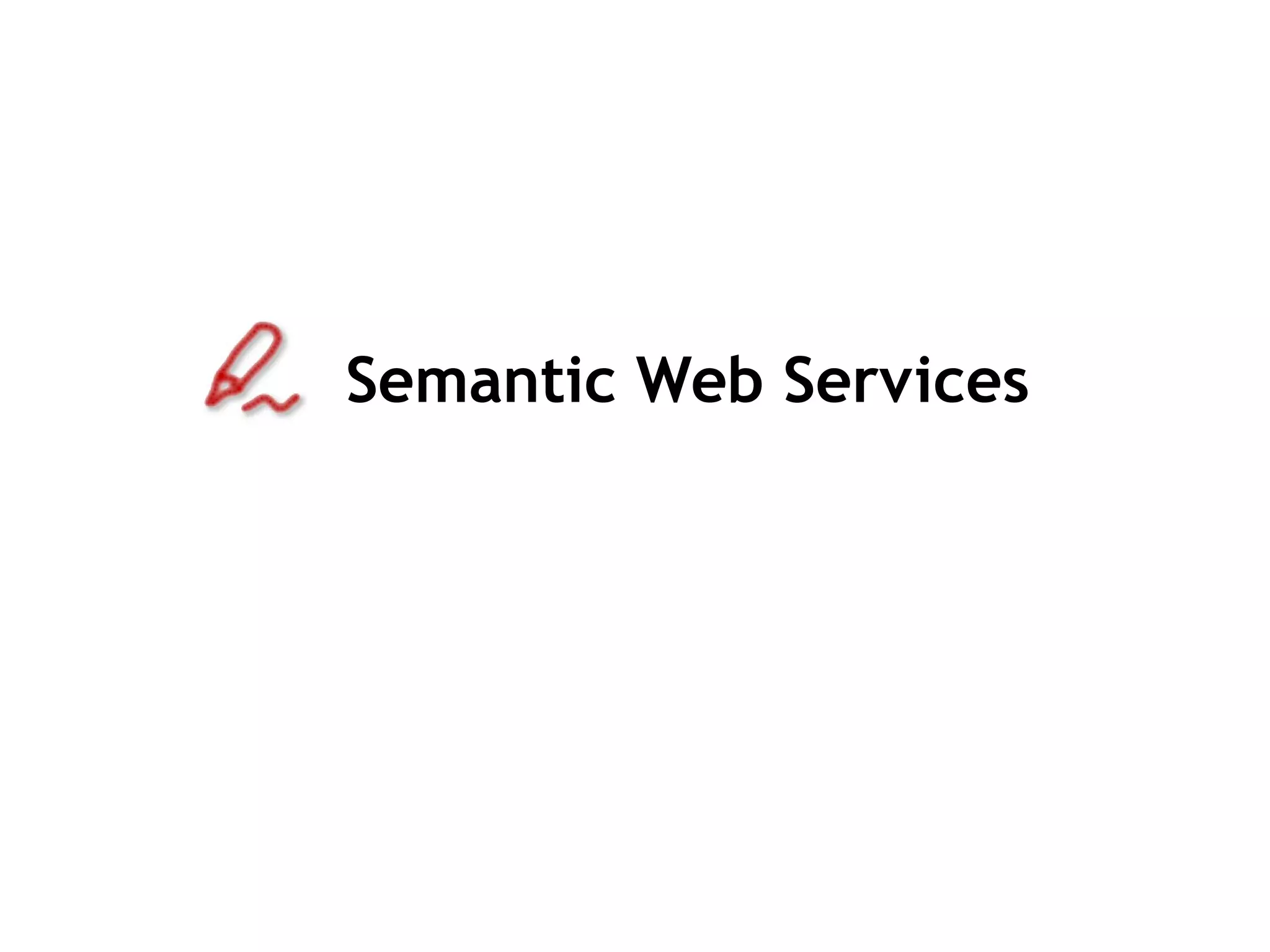
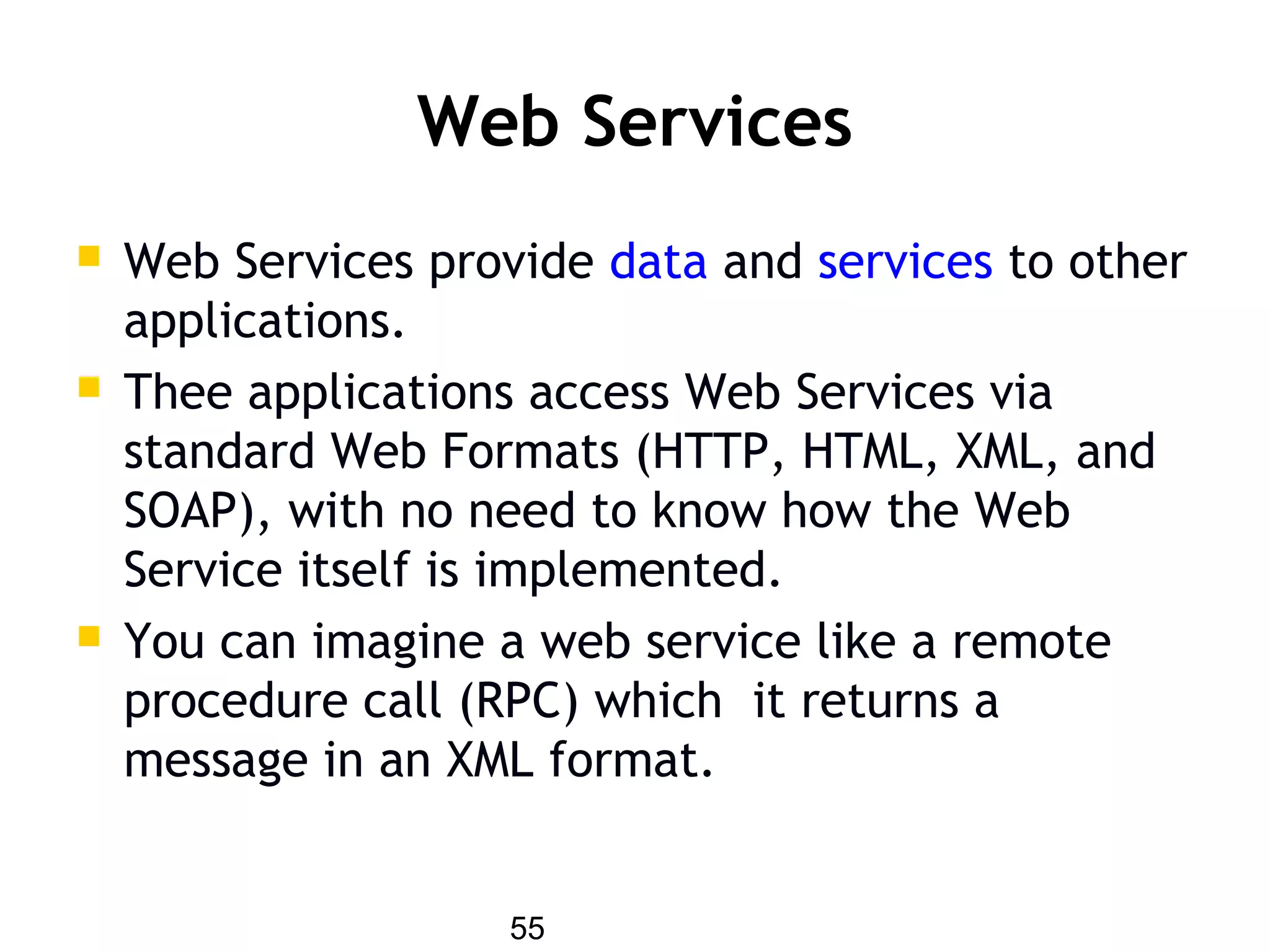
![56
Web Services
loosely coupled, reusable components
encapsulate discrete functionality
distributed
programmatically accessible over
standard internet protocols
add new level of functionality on top of
the current web
[Stollberg et al., 05]](https://image.slidesharecdn.com/introsemanticweb-150426100529-conversion-gate02/75/Intro-semanticweb-56-2048.jpg)
![57
The Promise of Web Services
[Stollberg et al., 05]](https://image.slidesharecdn.com/introsemanticweb-150426100529-conversion-gate02/75/Intro-semanticweb-57-2048.jpg)
![58
Deficiencies of WS Technology
Current technologies allow usage of Web Services
but:
only syntactical information descriptions
syntactic support for discovery, composition and execution
=> Web Service usability, usage, and integration needs to be
inspected manually
no semantically marked up content / services
no support for the Semantic Web
=> current Web Service Technology Stack failed to
realize the promise of Web Services
[Stollberg et al., 05]](https://image.slidesharecdn.com/introsemanticweb-150426100529-conversion-gate02/75/Intro-semanticweb-58-2048.jpg)
![59
Semantic Web Technology
+
Web Service Technology
Semantic Web Services
=> Semantic Web Services as integrated solution for
realizing the vision of the next generation of the Web
• allow machine supported data interpretation
• ontologies as data model
automated discovery, selection, composition,
and web-based execution of services
[Stollberg et al., 05]](https://image.slidesharecdn.com/introsemanticweb-150426100529-conversion-gate02/75/Intro-semanticweb-59-2048.jpg)
